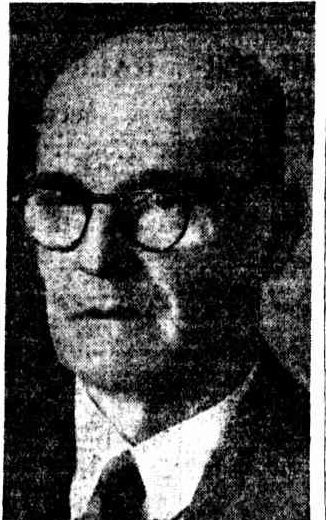Ella McFadyen's love of pittwater:
An Environment, Wildlife and children's Champion

Ella McFadyen, 1940's, photo courtesy State Library of New South Wales
Ella McFadyen (1887-1976) was a journalist, editor, writer of books for children, poet and amateur photographer with a passion for the environment (and inspiring youngsters to be amongst this through forming the Boomerang Walking Clubs), a deep love for animals, and sharing insights about the natural world with children. She conducted the Children’s Page of the Sydney Mail (as “Cinderella”) until that publication finished in 1938 and also wrote for the Sydney Morning Herald Women’s Thursday section, Australian Town and Country Journal and many other newspapers and magazines.
Her love of the great outdoors and Australia's wildlife, and sharing that with children, features in just about everything she did and wrote, while her passion for photography captured scenes and animals of here we may not recognise in some cases. Ella's words paid numerous tributes to our environment and bore witness to seeing the little things as much as the great landmarks that have not changed much since she first visited. Her responses to her child and young adult readers spoke of the peninsula and shared tidbits of information on everything from the flowers to the Seasons and weather and what can be found where.
Ella May McFadyen was born a second generation 'Australian' (or third generation if you take into account her mum was born here) on November 26th, 1887 at 'Burrundulla', John-street, Stanmore. Ella was one of five girls and two boys born to Donald and Mary McFadyen. Soon afterwards the family moved to 'Airlie' in Garfield street, Five Dock. The suburb of Five Dock was named, apparently, 'from the fact of there being five natural inlets or docks on the western bank' - or there were. The earliest documented reference to Five Dock is in the Sydney Gazette, February 3, 1805. In 1806, Governor King granted this bay to surgeon John Harris, who named it 'Five Dock Farm', and this comprised the entire bay, including the current-day suburbs of Five Dock, Abbotsford, Drummoyne, Chiswick, Russell Lea and Rodd Point.
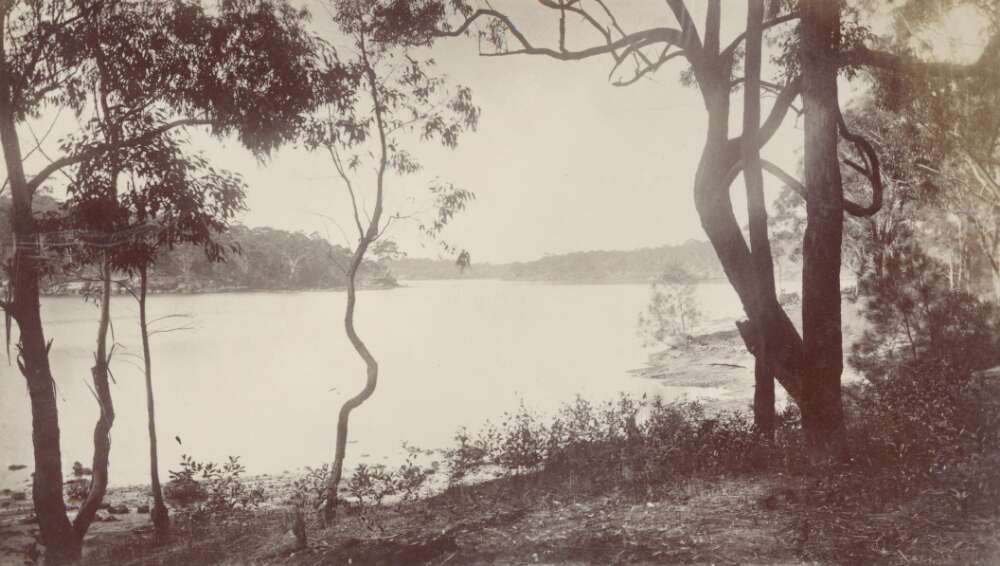
(1880). Parramatta River, Five Dock, Port Jackson, New South Wales, ca. 1880 Retrieved from http://nla.gov.au/nla.obj-140536671
The farm was eventually sold and broken up into smaller parcels of 30 to 60 acres and, being so close to town, began to be developed. By the 1890's, when the McFadyen family lived there, a tramway system had been installed making this area popular among those who had families who they wanted to have space and fresh air and who had to catch a tram to town to work.
While the family lived in Five Dock her two brothers were born as was another sister, while her youngest sister was born at Point Clare, Brisbane Water, in 1904, when the family moved there for a short time.
Her father was a businessman and did a far amount of travel as part of his job with photos which show some of the places, and buildings, he visited among the collection Ella McFadyen images held by the State Library of New South Wales. In her 1972 interview Ella describes going with her father in a motor car from Kempsey to Grafton for a trip (his work) and being the first to do so. [3.] A bit about him:
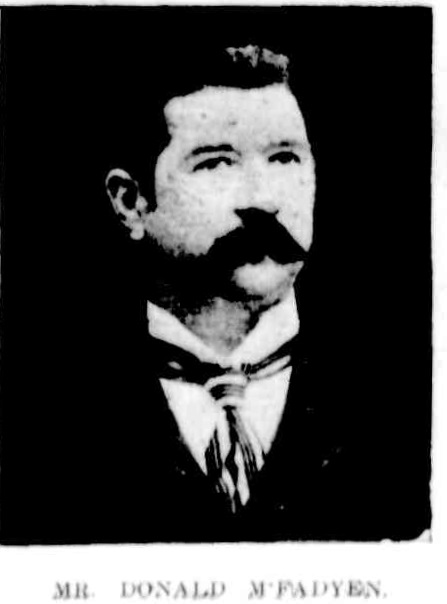
Ella's Father’s photo from: The Produce Trade of Sydney.—Some Views of Sussex-street. (1903, August 12). Australian Town and Country Journal (Sydney, NSW : 1870 - 1907), p. 32. Retrieved from http://nla.gov.au/nla.news-article71484758
THE FRESH FOOD AND ICE CO.
The New Manager.
Mr. Donald M'Fadyen, who has been appointed manager of the Fresh Food and Ice Co., Ltd., in succession to Mr. Lance, was born at Morpeth on the Hunter River (N.S;W.), in July, 1863, and consequently is now close on 39 years of age. He came to Sydney 15 years later, and entered into the services of his uncle, Mr. J. R. M'Fadyen, who was then carrying on business In Sussex-street as a produce merchant. In 1881, three years after his arrival in Sydney, he joined the old South Coast and West Camden Co. (now known as the Farmers' Co-operative Co., Ltd.) as a junior clerk, and by degrees worked his way up to his present position as manager of the company.
During his 21 years service he has worked through the various departments connected with the business, and in February, 1899, was made general manager. The business connected with the company, It may perhaps be Interesting to note here, embraced every branch of agricultural product, but dairy produce forms the great bulk of the trade, The operations of the company are very extensive, as will be j seen by the fact that In April alone the turnover, so to speak, amounted to £55,643.
Mr. M'Fadyen has made a special study for many years of the export butter trade, and the administration of the company's affairs has naturally brought him in touch with the whole of the Australasian markets, and he has at different periods visited the several States in connection with the butter trade. At his special request the company sent a representative to England last year to supervise the distribution of the company's consignments in the home markets.
Mr. M'Fadyen takes over his new duties as manager of the Fresh Food and Ice Co. on July 1 next. The appointment to him is naturally the more pleasing seeing that he did not seek It. The high esteem in which Mr. M'Fadyen is held by his associates in the Farmers' Co-operative Co. may be perhaps best understood by the. following resolution passed by the directors at a recent meeting —
"That the board learns with regret of Mr. M'Fadyen's retirement from the Farmers' Co-operative Co., with which he has been associated for very many years, and to which he has In the position he has occupied, and at present occupies, given his able and loyal support: at the same time the board congratulates him upon his appointment to the very honourable and responsible position which he has accepted in one of. the largest firms of the State, and heartily wishes him every happiness and prosperity in his new career."
In addition to having had great experience in the commercial line of business, he was at one time connected with municipal matters. For eight years he was an alderman, and out of the eight four were spent in the chair as Mayor of Five Dock. MR. D. M'FADYEN. THE FRESH FOOD AND ICE CO. (1902, May 26). The Australian Star (Sydney, NSW : 1887 - 1909), p. 7. Retrieved from http://nla.gov.au/nla.news-article229059319
CONCERT AT FIVE DOCK.
In aid of the prize fund of the Public school a concert and cantata was given in the Five Dock Town Hall last night, under the presidency of the Mayor (Alderman McFadyen) in rendering the cantata, "Australia," the pupils were assisted by several friends. Among the contributors were Messrs. G, Cooper, Goulding, Lucas, and Messrs Colyer, Burness, and others. The concluding item of the concert was a quartet entitled "Good Night, Beloved." Mr. Sharpe accompanied the singers. CONCERT AT FIVE DOCK. (1894, December 5). The Sydney Morning Herald (NSW : 1842 - 1954), p. 8. Retrieved from http://nla.gov.au/nla.news-article13998089
MUNICIPAL DISTRICT OF FIVE DOCK.
NOTICE is hereby given that the undermentioned gentlemen have been duly elected as Aldermen and Auditors of the above Municipal District:—
As Aldermen.
East Ward—Donald McFadyen.
West Ward—Oliver Howard Watts.
North Ward—Travanion Stapleton Rodd,
As Auditors
Ernest Langford Sutton.
Charles Thomas Kennett.
J. H. LUCAS,
Mayor and Returning Officer. 1st February, 1898. MUNICIPAL DISTRICT OF FIVE DOCK. (1898, February 18). New South Wales Government Gazette (Sydney, NSW : 1832 - 1900), p. 1314. Retrieved from http://nla.gov.au/nla.news-article220948630
MUNICIPAL DISTRICT OF FIVE DOCK.
NOTICE is hereby given that Messrs. K. F. and F. A. Palmer have been appointed Valuers tor the municipal year 1901-1902.
D. McFADYEN,
Town Hall, Five Dock, Mayor.
5th February, 1901. MUNICIPAL DISTRICT OF FIVE DOCK. (1901, February 15). Government Gazette of the State of New South Wales (Sydney, NSW : 1901 - 2001), p. 1180. Retrieved from http://nla.gov.au/nla.news-article226375295
Ella's father was the son of John McFadyen who was born on the Isle of Coll, Argyll, Scotland in 1829 as had her great grandfather, Roderick, in 1801 and her great great grandfather Donald McFadyen in about 1773. In a 1972 interview Ella states that her grandfather spoke Gaelic and he and his wife, Margery (nee McPherson), would speak this in the house when they didn't want the children to know what they were speaking of.
Roderick McFadyen and his family came to New South Wales in 1856 as things weren't too good on the Isle of Coll and those living there were encouraged to emigrate to places such as Australia and Canada. John McFadyen was already 26 when he arrived here and took up farming with his brothers and sisters at Morpeth on the NSW Mid North Coast. Donald McFadyen was born at Morpeth on July 31st, 1863.
On her mother's side there was a strong Irish influence, her grandfather on her maternal side, was Thomas Wilson (1814 to 1871) while her great grandfather was a Tim Kelly who came to Australia aboard the ship, 'Isabella Watson' with the 99th regiment.
Her father bought a paddock at Five Dock which Ella described as then being a green place 'with just a few pegs to tell you where the new streets were to be'. Her childhood at Five Dock is described as having pets - including a pet wallaby!, horses, a vegetable garden and a swimming pool. Her love of drawing animals both from nature and at the Museum filled her days.
Her father's firm was one of the first to use electric lights and he told stories about using electric lighting to speed up the construction of the Garden Palace, which burnt down soon after. Her father also told stories of the Hunter River including rescuing a drowning cow and sustaining it on the second floor of the house, until the water subsided. Her father liked horses but not gambling. Her mother disliked horses and forbade the children to go near them.
Ella was home schooled by her Mother despite the old Five Dock Public School being just across from the McFadyen 'paddock'. She learned Latin and grammar and although ruminated over having mother as teacher credited her sound sense and use of 'Gardiner's analysis' as providing her with the correct use of words and as words became her career, of seven decades in length as a poet, wordsmith, story teller and editor, her mother did very well indeed. Ella remembers reading Shakespeare's 'Hamlet' when aged 10!
alike those on the Isle of Coll, Ella did not attend school but ‘instead finding companionship in her dolls and the books her father scattered thoughtfully around the family home. In a sign of what was to come, she often spent her time reading, sketching birds at the local museum, looking through old diaries and notebooks, and pretending to publish newspapers…..’ [2.]
When Ella was almost 16 her mother fell in love with Brisbane Water - just across from Barrenjoey Headland, during a visit there during Autumn. It was at Brisbane Water that Ella's passion for writing prose and rhymes, previously created for her younger siblings, began to be shared with others. One about that place:
THE BROWN HAWK.
BY ELLA M'FADYEN.
The wind blows east, the wind blows west,
The wind blows over the pewit's nest.
Yes, the pewit's nest where the little ones lie cosily awaiting the day, so shortly to come, when they shall stretch their little wings and bid their home farewell.
Between the steep blue slopes of the hills and the tall line of old oaks that rim the shore the flat, with its grey-mossed orchards, lies all golden in the hazy afternoon light. Presently the sun will dip behind the high rampart of the hills, and the oaks stand out, pencilled finely against the sunset.
But the salt wind is singing softly about the pewit's nest and the big Brown Hawk is wheeling high in a sky of palest blue. From his height he can scan the far expanse of Brisbane Water, the points with their storm twisted trees, the roofs peeping out here and there, the misty gullies running up into the hills, and the grassy slopes catching their last glimpse of the sun.
With his great wing sweep, his fierce beak, bold brown eyes, and mighty talons, the hawk is a magnificent fellow, able indeed, thinks he, to hold his own among all the warring tribes of the. feathered world.
Far down by the channel he sees a fish eagle swooping to his prey, and landward, skimming low over the trees, a great crow makes his clumsy flight, attended by a train of chattering, abusive little birds. From time to time the big thief turns and charges his harassing but elusive foes, striking left and right with his heavy bill, but without effect.
The Brown Hawk is narrowing his circle of flight every turn, for the little pewits are exactly the supper to tempt his appetite. The parent birds, though, are ready to defend their home, and now they fly out upon him, fluttering about him, beating at him, even dashing in under his guard and plucking at his feathers.
Now the Brown Hawk is a thief if you like, but not a knavish thief. He is a gentleman of the road, and a fine one, with a professional pride in his calling. One may rob a pewit's nest and still do it artistically. While he would love nothing better than a battle royal for the spoils, these poor, distracted pewits are certainly not worthy of his prowess. So he merely ascends in a wide spiral flight, beating them down with his wings. It is a point of honour with the Brown Hawk never to seem in a hurry.
Higher and .higher soars the Brown Hawk, and far below him the garrulous blue jays cling to the swaying tips of the gums. The pewits are settling again on the nest when he drops straight, and swoops in upon them.
Up they fly in his face, and again he rises and wheels, repeating the graceful manoeuvre as though proud of the ease with which he could accomplish it. But the sun is drooping towards the blue ranges, already folded in their evening mantles, and supper must be had.
Then the Brown Hawk starts, actually swerves from his level poise, at the monstrous impertinence greeting his earthward gaze. Here is the crow— the base born, thievish outcast of the bird world, actually pointing his clumsy flight towards the pewit's nest.
In his indignation the Brown Hawk wheels in and drops sheer from his vantage point. Truly he is very indignant, else he had never neglected that first precaution of warfare.
But the crow is too intent upon the feast he has just espied to take advantage of his' foe's recklessness. He has no hesitation in attacking fiercely the frenzie :. , parent birds, dealing murderous blows to right and left as the devoted little creatures renew their desperate defence.
But the diversion they create serves the Brown Hawk well. Swiftly he soars, and dropping with fine precision, fixes his talons in his enemy's back, between the wings.
The crow is a giant of his tribe, and beating out now he contrives to thrust upwards at the Hawk's breast. The white feathers fall in a shower, and the Hawk looses his grip. It is only for a moment, but the crow gets in another deadly blow, a bludgeon stroke this time, with all his force. Then the Hawk beats up and drops, this time upon his enemy's head, and beak and claws get in their deadly work, ripping the thick sleek plumage till the scalp lies bare. This time the crow changes his tactics, ducking head down. The wind behind catches the wide wings and spread tail of the Hawk, toppling him forward.
Over and over, the birds fall together, thirty, forty feet, and when the crow steadies himself again with spread pinions, the lighter bird is still on top, and falls to, his talons red and dripping.
Already, though, the crow, sullen and dishevelled, has had enough. With a savage lunge, he wrenches free and veers out unsteadily across the bay. The pewits, watching with round, frightened eyes, weigh their chances, for the sun, a great globe of liquid orange, quivers on the upper rim of the smoky range.
Still the Hawk has his wounds, to avenge. With talons curved for the grip, he speeds out after the crow, who now turns to meet him with savage desperation. This time the crows scores, for the stiff wind blowing out here well-nigh disables the lighter bird. But the Brown Hawk is not to be baffled. He turns about, and, slowly at first, for he is spent, beats upwards in the teeth of the wind with heavy, labouring wings.
Along the shore the chattering and jeering of the smaller birds dies Into silence, broken only now and then by a drowsy twitter. The pewits nestle safely in, hushed to sleep by the soft evensong that the wind sings in the oaks, Still the Brown Hawk soars, a tiny speck in the pale, stainless blue.
Beneath, the bay glows rose-red in the sunset glow. Then in an instant the bright globe dips behind the range and its high ragged scarp flings a shadow, like a black cloak, upon the water.
With a low, sullen cry the crow flaps his black wings inshore. Right up into the heart of the shadow he flies, where only a dim thread of silver parts the dark bulk of the shore from the ink-black water.
Then from the invisible heights of heaven falls a tiny speck, sheer, clear, and swift, a speck that grows and shapes itself and takes life. The Brown Hawk fixes his talons in his enemy's head, shakes him from side to side, grips deep and deeper, the short, fierce beak rips and tatters — then he flings free and wheels upward into the heart of the glory, where rose and carmine, merge into molten gold, up and up where the eye dare no longer follow. . . . and down, down, falls a ragged, black bundle, over and over till the dark secretive water receives it with one momentary splash of silver. THE BROWN HAWK. (1908, November 18). The Sydney Mail and New South Wales Advertiser (NSW : 1871 - 1912), p. 1338. Retrieved from http://nla.gov.au/nla.news-article163230915
While living there she visited places along the waters in a little skiff and on one adventure found the stone in which Australian poet Henry Kendall had carved his name. Ella climbed a tree and took a photo of this using her little box camera and it was published in the Sydney Mail years before she joined that paper to run the two page Children's Page - known as 'Cinderella's Page' to generations of children and young adults. That little story and Henry Kendall rock photo taken by Ella:
KENDALL'S GLEN.
BY ELLA McFADYEN.
We left the road where it swerves upward through the orchards to Penang, and soon the mangroves aud ti-trees and wind-rustled swamp grass were left behind, and the bracken bristled up from the white sand track, all dimpled with the little hollows of the ant-lion.
The track leads down to the stone-paved ford, but we turned off past the old house beneath whose roof Kendall must many times have slept. Convict-built, of solid stone, and some 70 years old, it nestles among its grey orchard trees, and the sunlight draws warm tones from its weather-stained shingles and mellow-tinted stones.
Beyond Narara Creek our climb began up the rugged grey face of the range, till, breathless and weary, we halted upon a green tableland starred with flannel daisies and red Christmas bells, while from the slopes below us the coveted pink tops of the Christmas bush beckoned. Presently we came upon a little loitering stream, sunken under the sand here and there, only to reappear a few paces further on tumbling in a mimic cascade into little pools where the crayfish crawl and the dragonflies hover. Before us stretched a splendid panorama.
The stream led us to the abrupt, lichen-spotted lip of a rock-faced gully that dropped sheer at our feet. Over it the water leapt into music-haunted shadow, and the wind beat back on us a fine-spun veil of spray. A detour led us down steeply to the rocky floor of the gully till we stood beneath the fall—
that Silver singer far away
By folded hills and hoar.
Close by is the rough grey boulder with the clearly-cut inscription, 'H. KENDALL, 1874,' and below the letters 'G.L.F.'
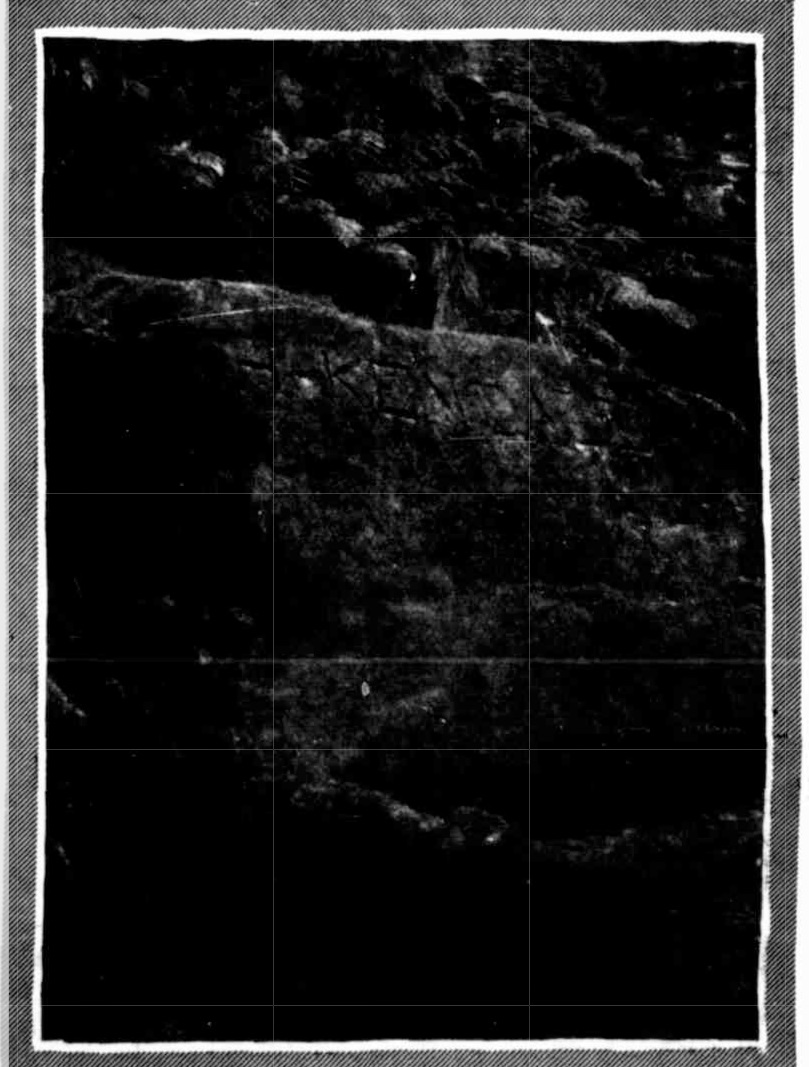
Standing in that remote and hidden sanctuary, with the written music of the poet blending in one's ears with the voice of the water dripping down the moss-boarded ledges, one might well indulge the hope that as it has lain undesecrated these 35 years past, so may it lie aloof and ever sacred from the hands of that old vandal — Change.
I wonder if the leaves that screen
The rock-pool of the past
Are still as soft and cool and green As when we saw them last-!
I wonder if that tender thing.
The moss, has overgrown
The letters by the limpid stream —
Our names upon a stone !
KENDALL'S GLEN. (1909, May 5). The Sydney Mail and New South Wales Advertiser (NSW : 1871 - 1912), p. 29. Retrieved from http://nla.gov.au/nla.news-article164294203
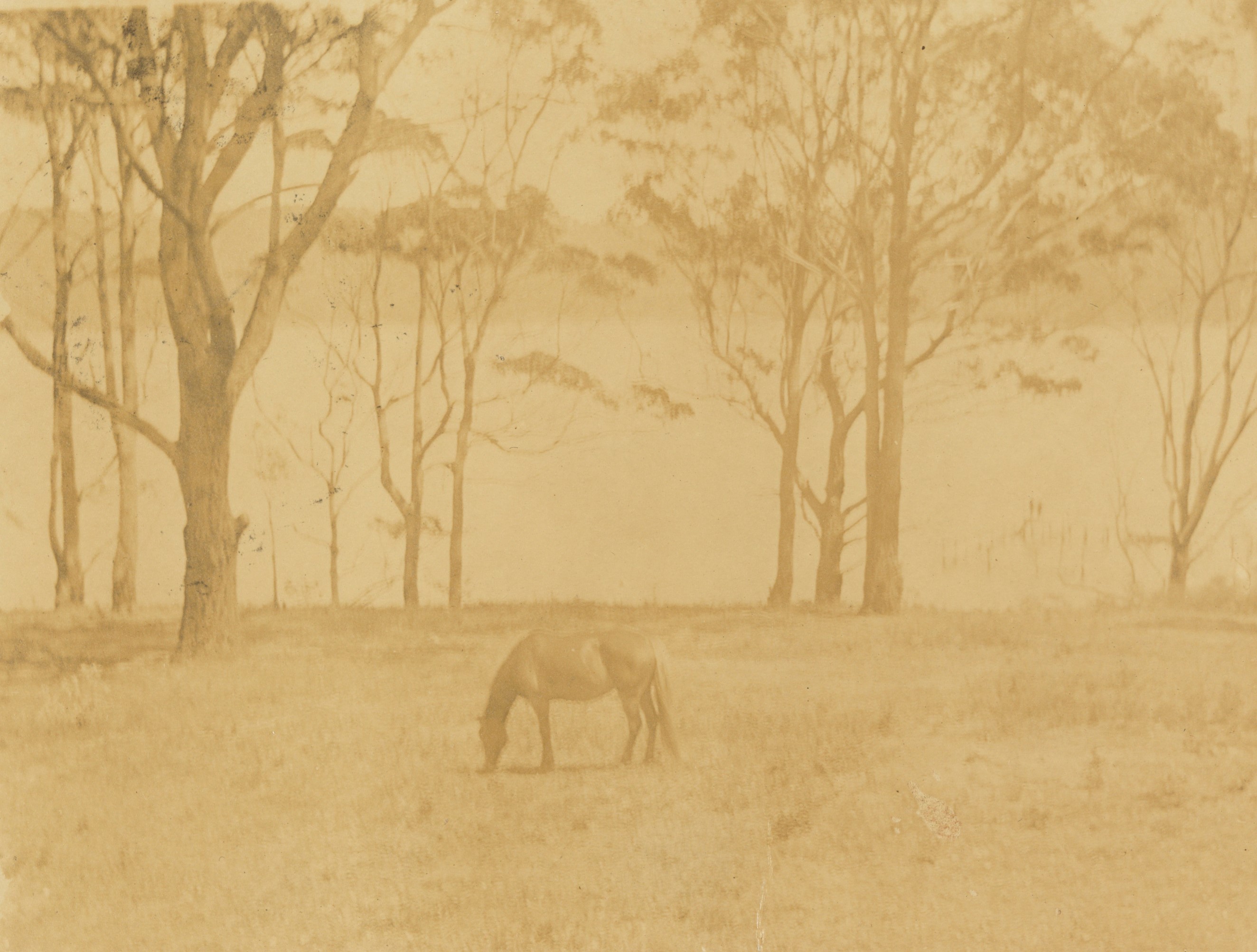
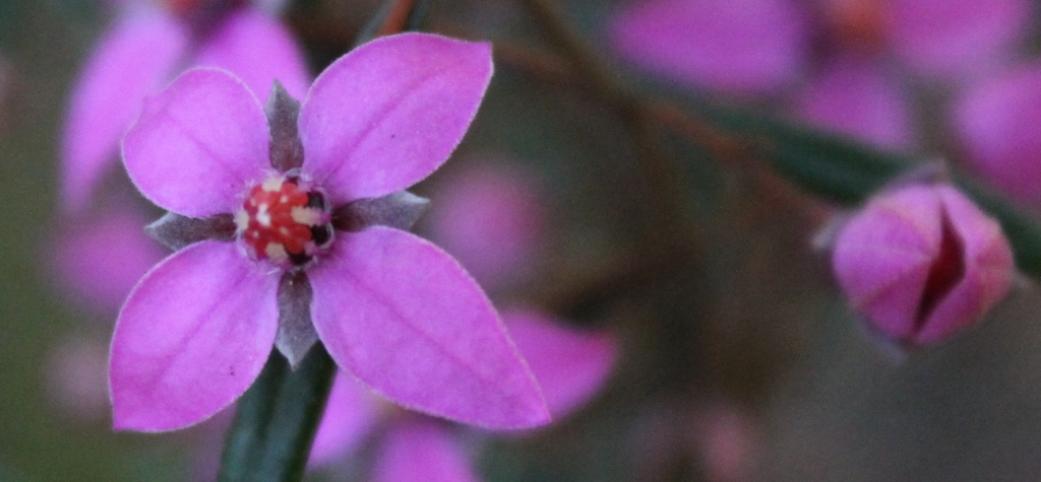
Boronia ledifolia - Sydney Boronia
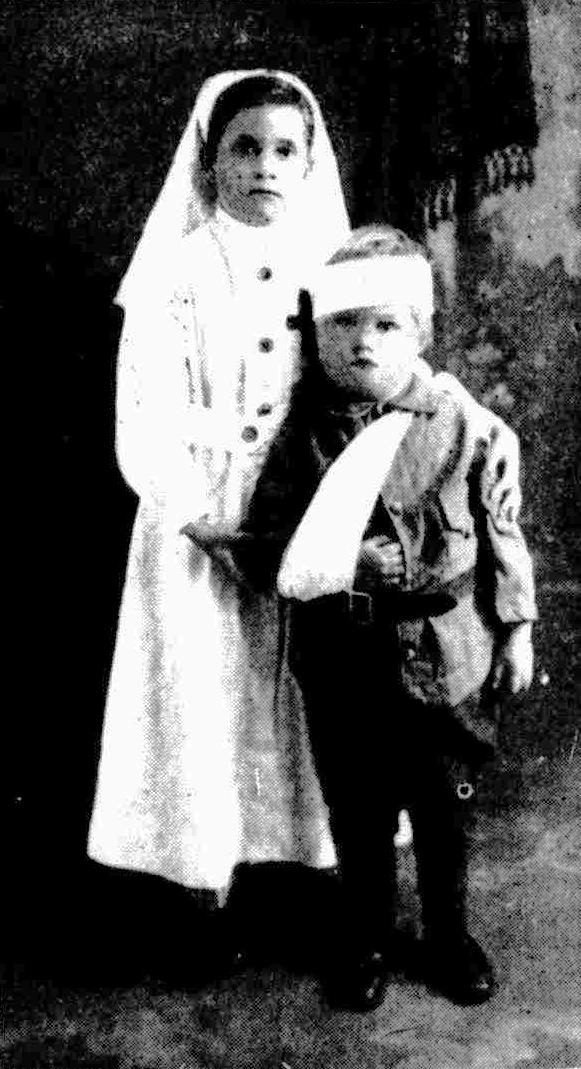

.jpg?timestamp=1569474894130)
.jpg?timestamp=1569474924631)
Fairies
THE CHILDREN'S PAGE.
Conducted by ELLA McFADYEN.
Boys and GIRLS — all you young Australians who are going to be one big family of friends, as we come together each week in reading this Page of ours — what did you think of the Editor's ideas last week? If I know anything about boys and girls — and, really, I ought! — I think you were delighted with the idea of a Page of our very own where we can have discussions and stories and letters and all sorts of jolly com-petitions. Do you remember in the 'Jungle Book' (and I know that lots of you have read it, because it is some times given as a school prize) all the wild creatures of the jungle met together at the Council Rock, and made their plans? Lots of fun they had on those moonlit nights, and interesting gatherings there must have been. But I think that if we held a council together, for all the boys and girls, big and little, we would have things almost as wonderful to relate.
BUSH LORE.
FOR instance, I have a very warm spot in my heart for the boy who loves Nature-lore. A big boy was telling me the other day about the tricks the lyre birds play, and, as they have played a few on me, I was keen on hearing. This boy had been down wild, remote Moonee Creek, where the poet Kendall used to wander, and he told me how the lyre-birds there mimic every-thing in the bush, and how one led him out of his way by imitating the delicious gurgle of a little stream over stones. Onward and downward he went through the tangled timber, thirstily picturing that cool water to himself, only to find at last the lyre-bird having a little concert all on his own, and no stream there at all!
IDEAS AND DYNAMITE.
BUT, of course, there are boys who prefer motor-bikes, or stamps, or engineering. Or perhaps one of you is an inventor. I once knew a boy who had an idea for running an engine with dynamite; but I am glad to say he never got further than drawing plans. Even if the first inventions are not successes, it will be nice to hear all about them and to exchange ideas, be-cause all the world's great inventors were once little boys, and all the best ideas were once just notions be-ginning to grow in some child's mind. I would like this page to be a sort of Hobby Club, where we can talk about such things, and where you can write and ask questions.
WHAT GIRLS CAN DO.
BUT what about the girls? I have a letter here from a girl who is very earnest in wanting to be a poetess. And I am not going to give her that tiresome old piece of advice, 'Don't!' because, even if she never becomes a great writer, her verses will help her to appreciate the beauty and happiness of life. Besides, plenty of successful writers began just as she is beginning. All the good ideas must have a little beginning somewhere, you know. There is a saying that 'in the heart of every man a poet has died young.' I don't see why our poets should be allowed to die, nor our artists, inventors, or explorers. I think that with a little help we could keep the good ideas alive and give them a chance to develop as the boys and girls get older.
FUN AT SCHOOL.
I DARESAY you all love dressing up, and most of you would like to act in a play. Some school-girls wanted to give a play for the Red Cross, and their trouble was that they had only the shabby school-room to act in and the old forms and presses for scenery. That did look like a difficulty, didn't it? But if you have read the adventures of Nicholas Nickleby you will remember that, the first time he had to write a play, he was asked to write it around a pump and some tubs that his friends had bought cheap. So he wrote a play with a great Pump Scene, and it was a huge success. The girls and I decided we could do as well as Nicho-las, so we wrote a school-play to suit the furniture, only to make it attractive we had school-girls of the day when curls and crinolines were worn. One girl was the school marm with snow-white hair, and the rest were her pupils.
Did you girls in the sheep country know that the curly locks of Lincoln wool, all washed and combed and stitched to a little close-fitting cap, will make the love-liest white wig for an old lady? Well, just try it if you get the chance. It was a great play, and there was a little mechanical mouse that slipped out suddenly and made great fun by sending all the girls scuttling on to the forms. We even had an epilogue, which is a kind of complimentary speech, spoken in verse. Everyone wanted the play repeated; but the point of it all is that the girls did all this them-selves, with just the least little bit of help. It is wo-derful what you can all do if you will let yourselves believe you can. And so that you may all tell me what you are doing we will institute straight away
CINDERELLA'S POST-BAG.
CINDERELLA is my 'really truly' name when I have letters written to me, and you all know Cinderella, the girl who wasn't the least afraid of rats and lizards, and who had such wonderful luck in raising pumpkins. Who has a letter to drop into my post-bag this week?
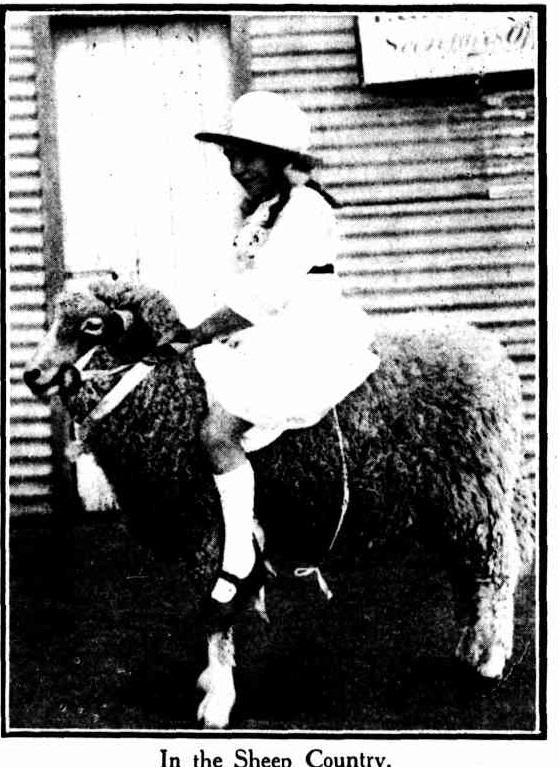
In the Sheep Country. This little girl, who lives in the Henty district, N.S.W., rode about the ground at the last Henty show on her pet lamb. She has two other lambs broken to saddle and harness.
OUR COMPETITIONS.
THE competition for girls is: 'MY FAVOURITE LESSON AT SCHOOL.' There is a Junior section, up to 12 years, and a Senior section, up to 17 years. A Certificate of Merit will be awarded for the best answer in each section. Write about 100 words. The competition for boys is : 'THE BEST HOLIDAY I EVER HAD.'' There is a Junior section, up to 12 years, and a Senior section, up to 17. A Certificate will be awarded for the best answer in each section. Write about 100 words. Note that the closing date for both competitions is FEBRUARY 4th. Send your name, address, and age with your letters. THE CHILDREN'S PAGE. (1920, January 14). Sydney Mail (NSW : 1912 - 1938), p. 27. Retrieved from http://nla.gov.au/nla.news-article159028090
From this first speaking to her Readers Ella is 'Cinderella' when they are sending letters to her. The Children's Page was also a place where Pen Pals were matched to each other, by 'Cinderella' many of these corresponding into adulthood with each other as well as with 'Cinderella'.
Faeries play a prominent and very important role in Scottish and Irish folklore, from the time that every waterway, well and loch had a name, and an ancient faerie that looked after or 'spoke' for it. Even people with strong religious beliefs embraced the notion of fairies, kelpies, and brownies in centuries past. Scottish fairy lore is rich with descriptions of these creatures and their habits.
“When the first baby laughed for the first time, its laugh broke into a thousand pieces, and they all went skipping about, and that was the beginning of fairies.” - Sir J. M. Barrie, Scottish journalist, writer, and dramatist (1860-1937)
“Fairies use flowers for their charactery.” - William Shakespeare, English dramatist and poet (1564-1616)
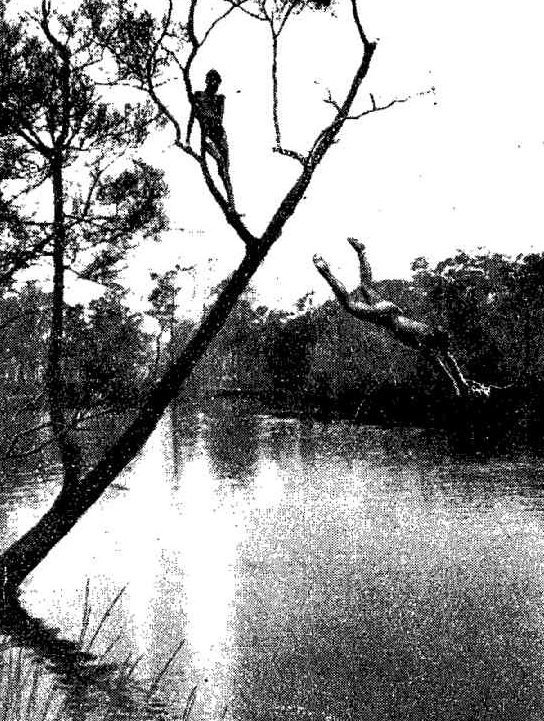
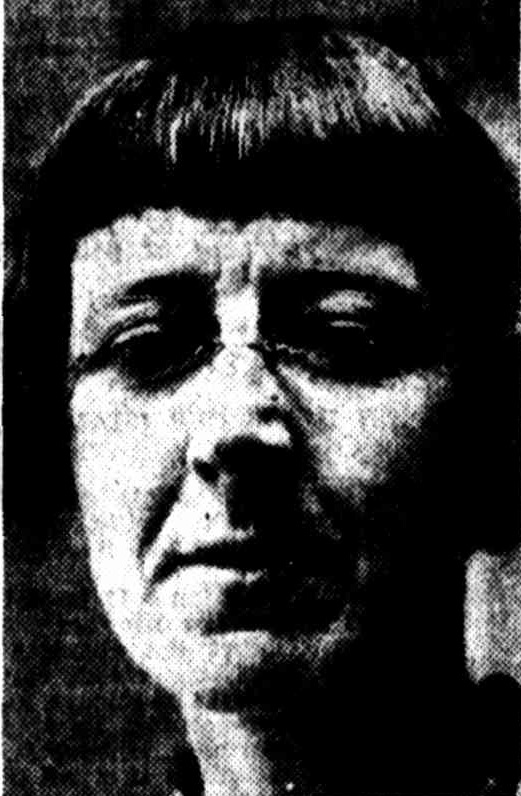
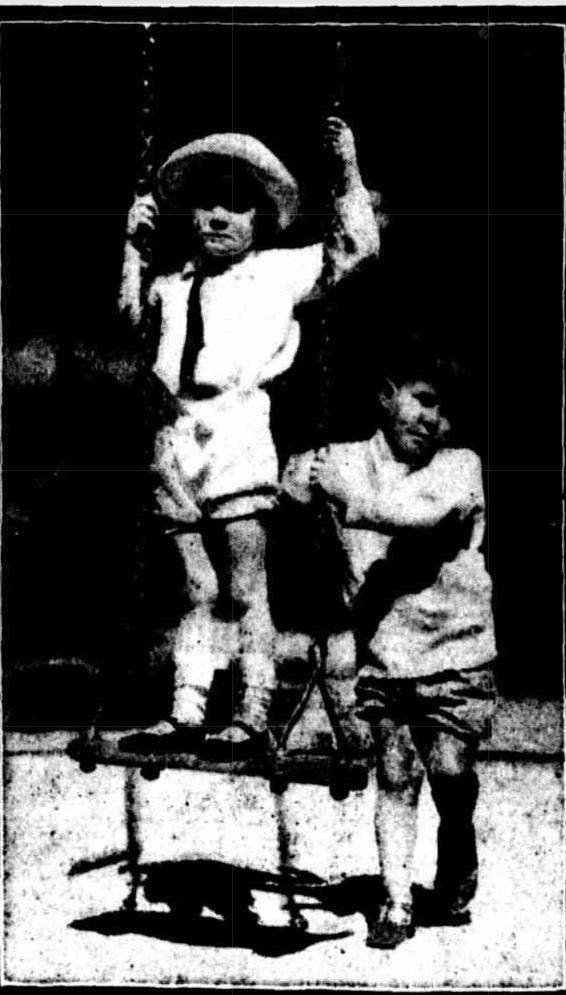
One of the etchings of Pittwater James Squire Morgan completed during the 1920's:
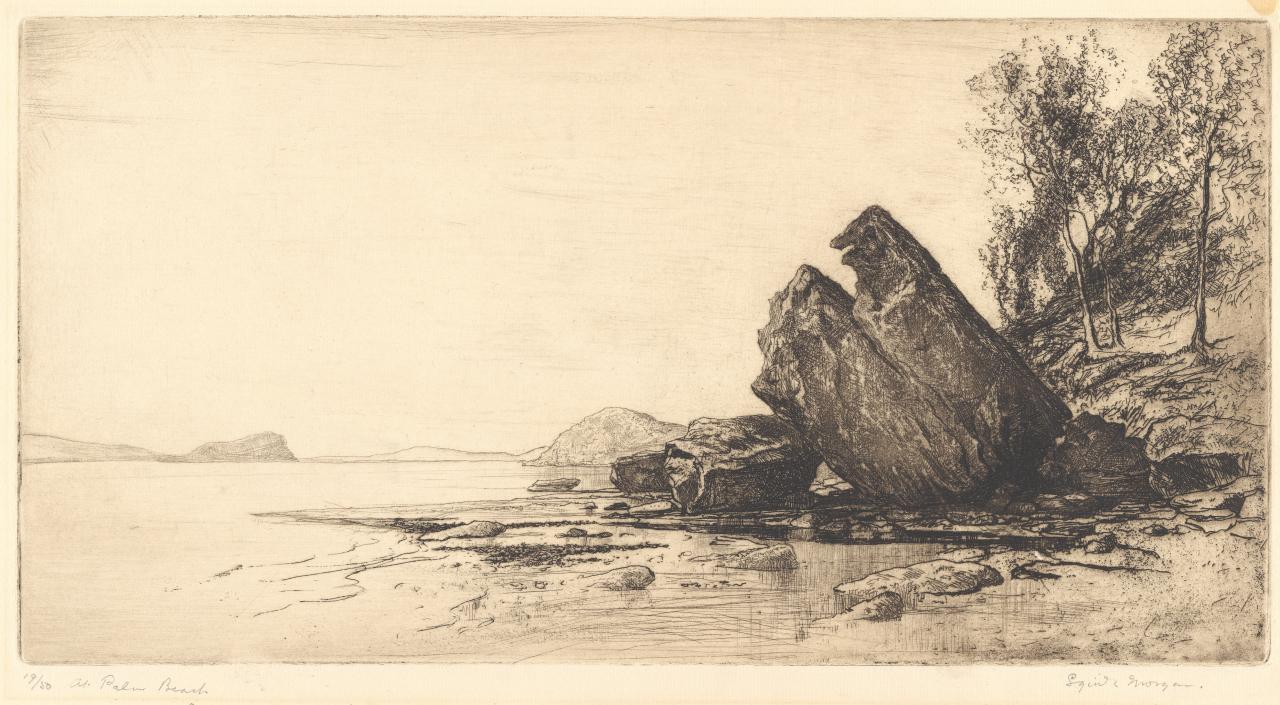
At Palm Beach (1920s) by James Squire MORGAN - from and courtesy National Gallery of Victoria, Melbourne, Felton Bequest, 1926 © Estate of the artist. Item: Df112248
The Boomerang Walking Club - pittwater days
'We were like the blacks; we wanted to live secretly, silently, have an unseen life'. [3.]
As she replies to her young Readers:
'KING INGODA' (Bourke) : The Boomerang Club purposely remains a small company with a high qualifying standard. We seek the solitude and peace of the bush; we detest noise and interruption and anything that spoils the native charm of our quiet excursions. Cinderella's Answers (1932, August 10). Sydney Mail (NSW : 1912 - 1938), p. 48. Retrieved from http://nla.gov.au/nla.news-article166226104
HELEN HOSKINS (Wollongong) : The Boomerang Club exists to train its members in efficient long-distance walking and to promote the study of bushcraft, Nature, etc. Most of our members are keen on botany, photography, bird-lore, and the literature of outdoor life. Only a small number of candidates can be accepted for this training, and, obviously, only those who live convenient to Sydney. Guests from the country are invited to share our walks when possible. Cinderella's Answers (1937, April 21). Sydney Mail (NSW : 1912 - 1938), p. 48. Retrieved from http://nla.gov.au/nla.news-article160502078
Living at Lindfield their walks frequently brought them to Pittwater, and Broken Bay, where she could gaze across to an old favourite home on the Central Coast, with many a tramp through the Ku-Ring-Gai Chase National Park and even to Barrenjoey. However, Palm Beach was also a place just for respite - the 'First Correspondent' referred to here is her sister Eunice, who would soon marry a pen-pal from Queensland:
The Children’s Page
Conducted by Ella McFadyen
Little friends who wish to visit Cinderella are reminded that the time to call at the 'Sydney Mail' Office, ' Herald ' Building, Pitt and Hunter streets, is between 10 and 12 on Tuesday mornings. Cinderella is on the second floor.
A Sea Change
When First Correspondent and Fairy Godmother returned from their three weeks of holiday in Queensland Cinderella, said that it was quite time she took, if not a holiday, at least a change.
UNFORTUNATELY, holiday was not quite possible. There was too much to do. However, she put some things in a bag, bought new bathing shoes, and fiddled about with her typewriter till she discovered the locking gear that is supposed to ensure safe carriage to the portable models. Of course, it would have been more fun lo leave the typewriter and take the camera instead, but that could not be. Ali Baba, with a deep distrust in his golden eyes, got between the adventurer and the garden gate and wept aloud. No one needs to tell him what packed bags mean. Even a last-minute gift of sardines did not quite mend that small broken heart. It is sad business leaving one's pets; but that once over, heigh-ho! for Palm Beach and the surf.
At Palm Beach one may sit in a deep balcony (made from the rough stone which seems to be the typical architecture of that holiday land) and look up over the surf and the dunes to Barranjoey Lighthouse. See that spelling? Mr. Russell, who tends the lighthouse and really must know, says that Barranjoey and not 'Barrenjoey' is the correct form officially accepted, and he pointed to the lettering on a locker in proof thereof. In the early days (the lighthouse was opened in 1880) 'Barrenjuey' was the recognised form, but that has been discarded.
It is a windswept place, that lighthouse hill with the brown stone building of the lighthouse and its residence and high-walled garden looking rather like a fort built to defy invading elements. Lower down the slope, on the sheltered side next to Pittwater, there is pretty vegetation and a nice little rocky stair of rough stones. Flocks of wild goats wander about, not very brave in spite of big horns and long beards; and down at the foot of the hill there is a shed where a man once kept a little museum of snake-skins and such trophies he collected. He had the skin of an echidna there and some really fine snakes and iguanas.
A pity he could not have collected for his trophies the wobbegong some fishermen left on the beach. This, perhaps the only really comic member of the shark family, was about five feet long and very fat. He had a foolish face with fringy things like seaweed for whiskers, and such queer fins that they looked almost like little legs. He probably used them for scuffling along the bottom of the pools, for he hunts about on the bottom, I think
‘When my glass slippers wear out,'' said Cinderella, I shall get a pair of shoes made from the beautifully patterned, carpet-like skin of a wobbegong — after having it soaked for a twelvemonth in eau-de-cologne.'
WHEN the morning dip was over and the morning work of getting together copy and answering letters (those letters that never cease for a day!) had been faithfully attended to, came freedom. They were mostly companioned hours, too. Francis Sherwood, our Nana Glen member, shared a day: and 'Split-pin.' who will be remembered only by our most ancient members as one who occasionally made daring lightning raids across the border of the Ingle Nook, shared another. Once there was David, who is going to be a member some day, but is only five as yet. Sheila, too, was a little girl-chum with a genius for showing one nice walks. In passing we must wish her success with her bursary exam. Then there was an old sea-eagle who was rather good company along the cliff at evening. He went out at that hour to do his perilous fishing, and once came back trailing something that looked like a slingaree with a long tail. Jock, a long-headed Scotch terrier with an approachable heart that really belied his extraction (Scotch terriers should be a little dour and slow to be friends, but Jock always loved at first sight anyone who would take him home to tea and biscuits), was always ready to accompany one on a walk.
Once a dauntless company of adventurers (three in number) set off on the Newport 'bus, with an enormous picnic basket, and made their way through the callistemon scrub, that seemed all afire with blossom, towards the cliffs where hides the Hole in the Wall. There was some good scrambling before the basket was set safely on a ledge and the steep path to the cave was discovered and essayed. It is a most impressive cave, full of the footmarks of little wild creatures, and very dark and cavernous towards the rear, where a fall of rock has blocked what, was, I believe, at one time a landward exit. Anyway, it was a good cave for adventures, and could quite suitably, have been used to hide a chest of pirate treasure. (Anyone want to fit out an expedition to go there and make sure ?) It was pity Cinderella did not have her camera along that day: but she could hardly have taken a snap of herself dauntlessly climbing up to the cave mouth, and the comrades below were too steeply below to have done so, either.
BEST of all times, probably, were the lonesome rambles along the cliff path, when one could shout reams of Gordon's glorious 'Song of the Surf' with no one but the sea-eagle to hear. Most people at the seaside murmur bits of 'Sea Fever' and other Masefield fragments, and lots more no doubt think of Byron, even if he is considered too out-of-date to quote aloud; but all proper Australians should get 'The Song of the Surf' by heart before they go down to the sea. Out on the rocks towards Whale Beach, where one can gloat over the pools of sea anemones (pools lined with crystal and velvet and sprinkled with jewels, where the many-coloured living blossoms quiver and unfold), one could hear the big waves whooping in over the sunken ledges and feel the shock of them as they surged through the hidden channel beneath, making all the rocky bases of the cliffs shudder with their force. Only then did one get in full the sonorous splendour of Gordon's lines —
You come, and your crests are hoary with the foam of your countless years;
You break With a rainbow glory through the spray of your glittering tears.
To watch the breaking of a high surf on these great rocks and realise the immensity of the force that sends them swinging in is to touch the verge of a very great discovery — a thing that breaks like a dazzling light and soars splendidly above the power of words into the realm of conviction. Then the waves fall back from the cliff in a smother of foam; the sea-eagle, swoops and wheels again to the land, and the great discovery, that a moment since was about to solve all mysteries, is caught up again just beyond human understanding. The mystery remains.
When against the rocks he was hurled, and sucked again to the sea,
On the shores of another world, on the brink of eternity.
On the verge of annihilation, did it come to that swimmer strong,
The sudden interpretation of your mystical, weird-like song ?
The lines ought to be graven on a stone slab along the cliff path for the joy of all who love poetry and the sea, and the swinging, rhythmical waves of both. And that brings us back to the earth and the realisation that the seaside days are spent; that there are hundreds of unopened letters lying everywhere, and the Poetry Competition ought to be judged. It has been held over quite long enough. Children's Page (1928, October 31). Sydney Mail (NSW : 1912 - 1938), p. 54. Retrieved from http://nla.gov.au/nla.news-article158404607
Which home Ella stayed in is not recorded - from the earliest though, her tenacity in wanting Australian stories for Australian children, as well as photographs of children's playgrounds, lends itself to the conjecture that she and Maybanke Anderson (nee Wolstenholme), who also was published by Angus & Robertson, must have known each other. Her eldest son Harry, a lawyer and passionate ornithologist, was also part of the Palm Beach Land Company and one of the early owners of a beachfront home and weekender at Palm Beach and the family had a terrier named 'Jock':
.jpg?timestamp=1544130612932)
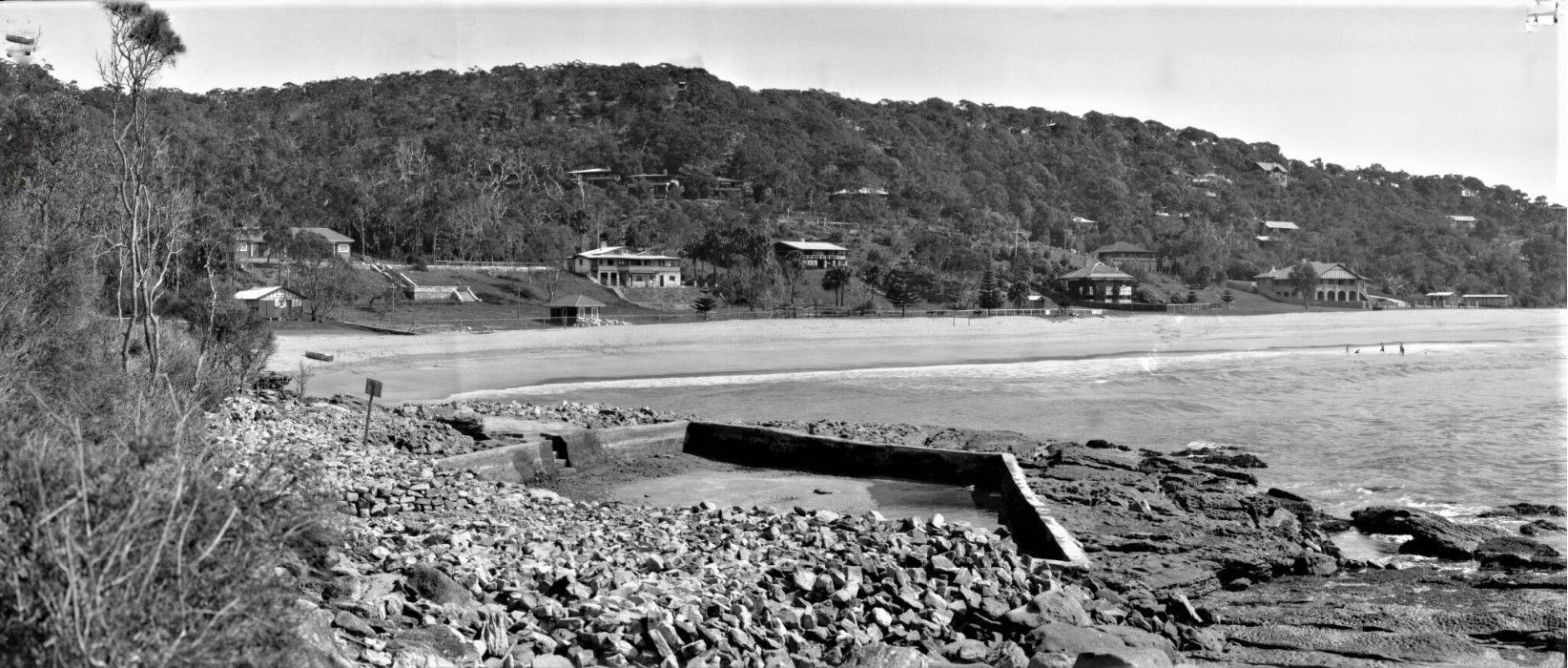
.jpg?timestamp=1544130747931)
.jpg?timestamp=1544130775468)
.jpg?timestamp=1544130667126)
.jpg?timestamp=1544130862800)
Maybanke was supported by the Gordon Craig family for decades in establishing children's playgrounds and kindergartens, and this family also had a home atop Palm Beach on Pacific Road (where their daughter, Artist Ailsa Craig, would entertain Thea Proctor when she stayed with them). Ella was a founding member of the Society of Women Writers NSW as well and all of these women and Artists supported each other's work, and women's financial independence, through that too:
Mary Brown Craig (wife of Francis Brown Craig - youngest brother) acquired three blocks on Sunrise Hill (No.s 161, 162, 163) where Craigie-Lee was built. James Brown Craig, the middle brother, had title to three blocks on Ocean road in 1921. Here a house named Tigh-Na-Mara (Scottish Gaelic 'the house of the sea') was built next door to The Palladium but no longer exists - a victim of fire. Ella may even have known Marie Byles, an enthusiastic bushwalker herself and similarly independent woman, whose family also had a home on Sunrise Hill looking towards Barrenjoey. They may even have just taken rooms at Florida House, which was a year round boarding house for visitors during this period.
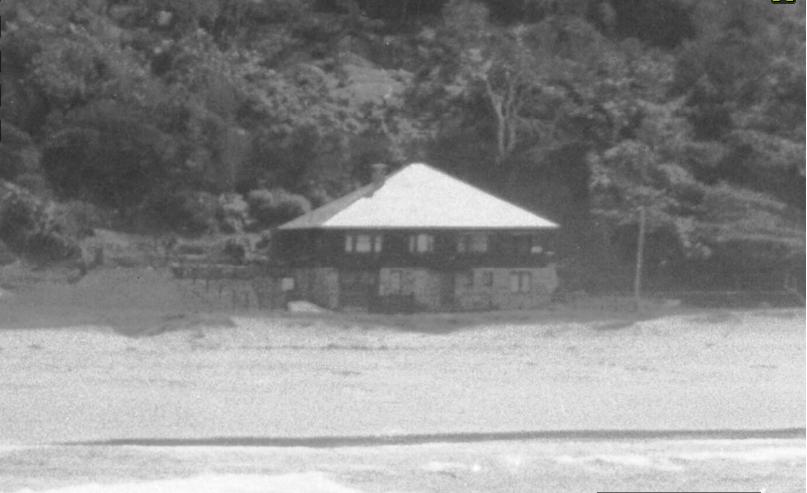
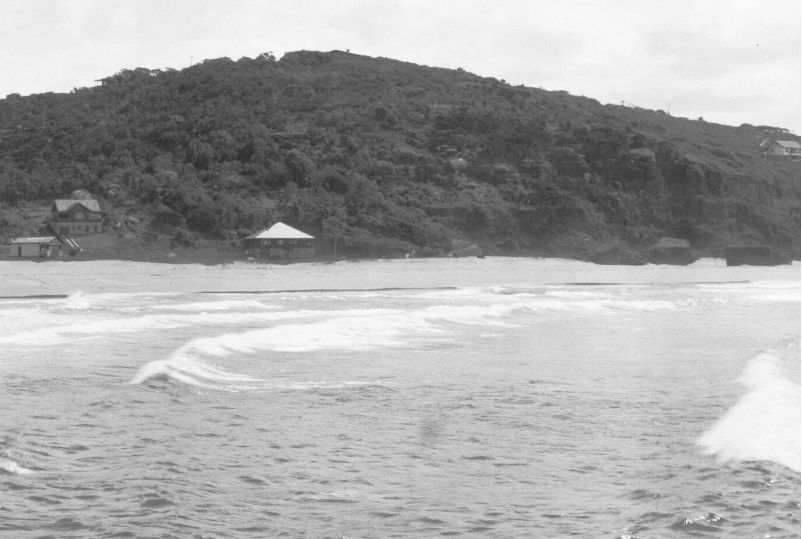
WEDDINGS.
CAMERON-MCFADYEN.
The marriage of Miss Eunice McFadyen. daughter of Mr. and Mrs. Donald McFadyen, of Wondabyne, Lindfield, to Mr. Clarence Johnston Cameron, elder son of Mr. and Mrs. J. B. Cameron, of Erracht, Beechmont, Queensland, took place at St. Martin's Church, Killara, yesterday morning. The Rev. L. Charlton officiated. The bride wore a gown of cream guipure Iace, finished with parchment-coloured satin, cut high to the neck, and with long tight-fitting sleeves. Her hat of hand-woven straw was trimmed with roses and she carried a shower posy of frangipanni and gold roses. Miss Ruth Wilson, cousin of the bride, acted us bridesmaid. She wore a period gown of pale pink georgette banded with folds of mauve satin, and a hat of amethyst hand-woven straw. She carried a bouquet of mauve gladioli, and pale pink carnations. Mr. Lindsay McFadyen was best man. After the ceremony the guests were received at the bride's home by Mrs. McFadyen, who wore a gown of black satin, with a black hat relieved with vieux rose. She carried a posy of pale pink roses, mignonette, and heliotrope. Mrs. Cameron, mother of the bridegroom, wore a fawn crepe-de-Chine frock, and hat to tone, and carried a posy of blue delphiniums and gold roses. The bride left for the honeymoon wearing an ensemble of kasha cloth, in tones of autumn brown, the coat being finished with leather trimming. WEDDINGS. (1929, February 27). The Sydney Morning Herald (NSW : 1842 - 1954), p. 11. Retrieved from http://nla.gov.au/nla.news-article16534461
Ella's Readers get to hear about it too:
An Interesting Wedding
A WEDDING which our correspondents have anticipated with interest look place at St. Martin's, Killara, on February 26th, when Eunice Graham McFadyen, of Lindfield, was married to Clarence Johnston Cameron, of Beechmont, Queensland. The pen-names by which the bride and bridegroom were known on the C.P. were "First Correspondent" and "Macnore." The bridesmaid was Ruth Wilson, who formerly corresponded under the pen-name of "Pandora." The ceremony took place in the morning, and it was a further happy connection with our club that the presence of Miss Maud Owen at the organ was due to her introduction to Cinderella by a group of our Eltham correspondents. After the wedding luncheon, at which only a few immediate relatives and one or two Ingle Nook friends were present, the bride and bridegroom left for a motor tour of the South Coast. After a brief stay on their return to Sydney, they will proceed by car to Beechmont, where they are to make their home. Among the gifts made to the bride were some charming mementoes from members of the Cinderella Club, the staff and pupils of Eldinhope, and the Old Girls' Union of Wenona College. The photographs were kindly taken by "Bing Boy," of the Ingle Nook. An Interesting Wedding (1929, March 13). Sydney Mail (NSW : 1912 - 1938), p. 54. Retrieved from http://nla.gov.au/nla.news-article166258076
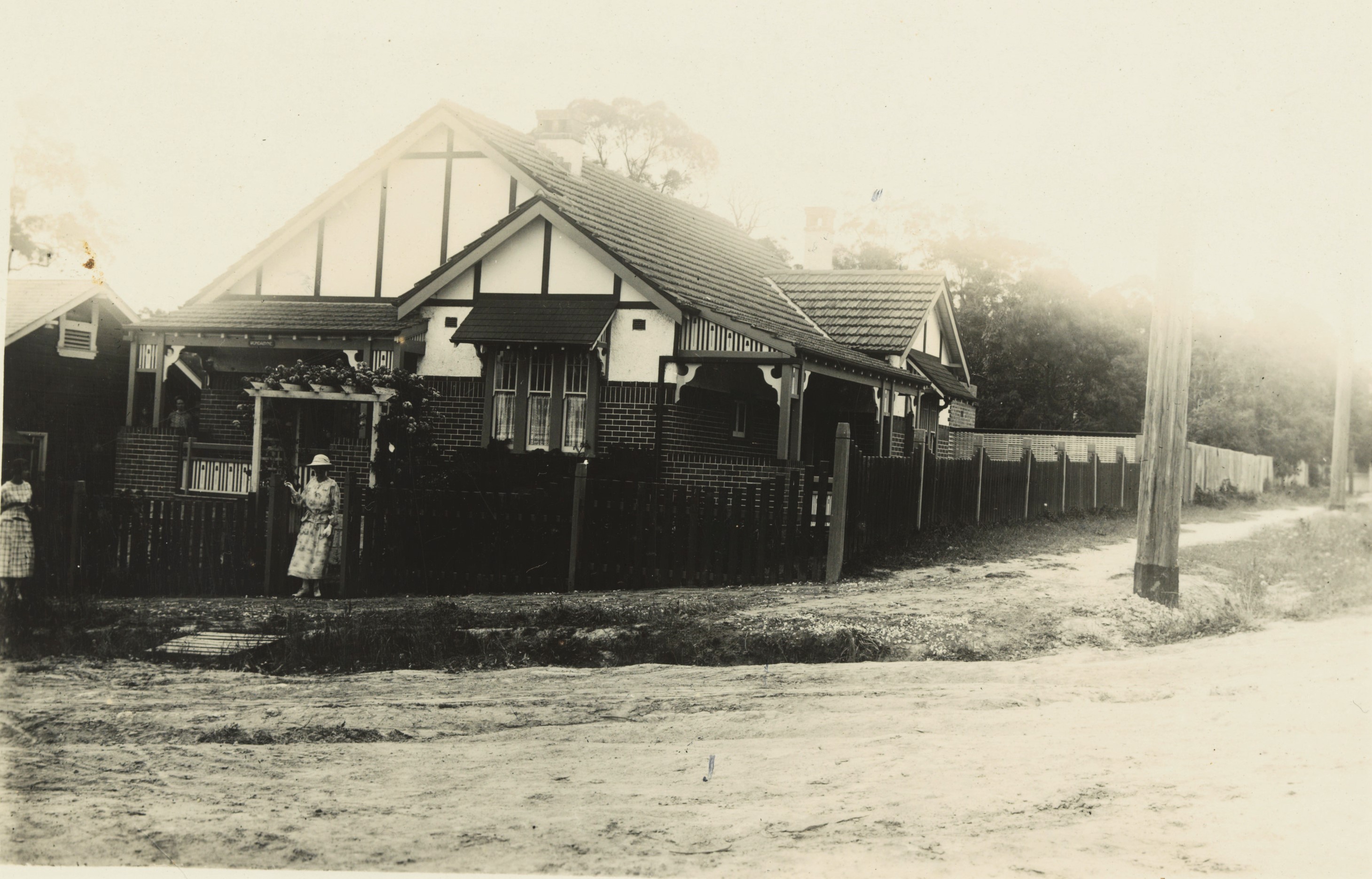
Item c078560078 and c078560079 (back) reads '24 Kenilworth Road, Lindfield - McFadyen home' - from Ella's Series 04: Residences, homesteads, factories and farm buildings, mainly New South Wales, ca. 1879-1953 / collected by Ella McFadyen - from the collections of the State Library of New South Wales.
Her brother Lindsay would marry a Queensland girl too:
Social and Personal
WEDDING BELLS
McFADYEN-MADDISON.
ROCKHAMPTON, September 12.
At St Peter's Church of England, Southport, on September 7, Miss Edith May Maddison, eldest daughter of the late Mr L. M. Maddison, Kilcool station, Central Queensland, and Mrs Maddison, Southport, was married to Mr Lindsay McFadyen, elder son of Mr and Mrs D. McFayden, Lindfield, Sydney.
The Rev. K. A. watts officiated.
The bride, who was given away by Mr E. W. Webb, wore a street frock of azure blue grenedine, with white accessories, and a bouquet of deep red roses.
Relatives and friends were entertained at afternoon tea at the home of the bride's mother after the ceremony. Social and Personal (1940, September 19). The Central Queensland Herald (Rockhampton, Qld. : 1930 - 1956), p. 27. Retrieved from http://nla.gov.au/nla.news-article75438887
While her father would continue to pen letters in his area of expertise, with a home address given as Lindfield:

MILK CONTROL (1942, January 24). The Sydney Morning Herald (NSW : 1842 - 1954), p. 10. Retrieved from http://nla.gov.au/nla.news-article17784830
While Ella would lament the changing landscape of the metropolis and run to Narrabeen, Dee Why, Pittwater and Broken Bay:
AUTUMN AT TARONGA.
Autumn at Taronga and the white gulls be-
low,
Where, like a drift of petals, the little yachts
blow.
Plumy tops of foliage lifted to the blue;
Trickle in the shadows where a stream runs
through.
Little twisty pathways, that dip and climb
and meet;
Lilt of childish voices and full of little feet,
Tier o'er tier the gardens, dipped in Autumn's
dye—
Like arras on the balconies when a king went
by!
Lantana red and golden, the amethyst and
rose
Of asters on the terraces, and phlox, and
golden glows.
Purple for a fairy prince, coxcomb for his
fool,
Mirrored in the wanderland of the beavers'
pool.
But very old and sorrowful, in a foreign
land,
The little mother monkeys take their
children by the hand.
Autumn at Taronga, with the promise in the
air,
And if the fairies love you they will surely
send you there.
Where slow swans are dreaming of Deewhy
lagoon,
And mopokes are mourning for crickets 'neath
the moon.
A new song crooning in the wild birds'
throats,
And the big bears begging in their brand-
new coats.
If you want the elephant, knock upon the
door;
Better take a little guide to teach you all
the lore—
How squirrel likes to meet you, and cockie
asks for cake,
But, 'spite of all your coaxing, the wombats
never wake.
Learn its lightsome humours, love its beauty,
yet
One thing in the garden I would I might
forget—
Alien and pitiful, and very old and wise,
The little monkey-women with the sor-
row in their eyes!
Lindfield. ELLA McFADYEN.
AUTUMN AT TARONGA. (1925, April 11). The Sydney Morning Herald (NSW : 1842 - 1954), p. 9. Retrieved from http://nla.gov.au/nla.news-article16214509
INVASION.
At Lindfield, past the station lights,
When dusk came down o' winter nights,
Bloom-dark as grapes, o'er-skyed with grey,
The little hills towards Deewhy lay.
The little hills in mist and rain—
Dear heart To tread their steeps again.
We two, remote with rock and sky,
The blown mist and the black swan's cry.
At Lindfield, where the taxis park,
Mew walls exclude, the ancient dark,
And in the all-pervading glare
The fiery neons writhe and flare.
Till I must shut mine eyes to see
The hills so dear to me.
ELLA McFADYEN.
INVASION. (1934, December 15). The Sydney Morning Herald (NSW : 1842 - 1954), p. 11. Retrieved from http://nla.gov.au/nla.news-article17138419
More on the Boomerang Walking Club:
Walking Club Notes
SO much interest has been shown in our Boomerang Club walks and camps, and the one-day rambles of its junior branch the Greenwood Club, that Cinderella would like to see our C.P. boys and girls form their own local clubs along similar lines— small parties being at all times the most enjoyable. As we walk to promote health, endurance, and efficiency, and to encourage self-discipline, as well as to amuse themselves, the Boomerangs have rules to which they adhere strictly. In the matter of dress, neither the freakish (such as one sees all too often) nor the slovenly is tolerated. Camping arrangements, while simple, are carefully planned to avoid unnecessary hardship, and the selection and carriage of food are calculated to avoid overloading the packs or risking deterioration of content.
A well-trained walking club need not cease its excursions in hot weather, as was proved by the fact that the Boomerangs made full use of their New Year as well as their Easter holidays; but beginners do well to start training in cool weather. In order to help our readers to plan their walks on the best lines Cinderella will publish a short series of articles on the topics of most importance to walkers, such as winter and summer dress, footwear and care of the feet, camp equipment, portable bedding, rations, and how to park them. Some of the adult clubs already organised are doing very good work; other parties one meets are mere 'bush-crawlers'— not walkers at all, lounging along in absurd clothes and carrying huge packs of food to very small distances. We do not want to waste our opportunities like that. The articles will begin next week. Walking Club Notes (1932, April 20). Sydney Mail (NSW : 1912 - 1938), p. 48. Retrieved from http://nla.gov.au/nla.news-article160080599
Walking Club Notes
By Cinderella
LAST week the topic was raised of how far our ramblers should travel in a day. On a tour of several days it is wise, if possible, to alternate long with fairly short stages, thus evening up the strain. In single - day trips the walkers may extend their powers to the full without fearing tired feet for the morrow. But in no case should walkers 'go till they drop' just for bravado, and no untested walker should be admitted to a long-distance tour. While it is natural for the boys and the stronger walkers to offer help to the weaker ones, no one worth her salt likes to have her pack carried for her. An even efficiency is the thing to aim at, and for this reason walking clubs should grade their members into small groups (half a dozen is a pleasant and sufficient number) of tested capacity and speed. Otherwise a plucky beginner may knock up in trying to keep up with seasoned walkers, or the day may be spoiled for the good walkers in hanging back for a laggard. In the Boomerang Club we try out our junior grade (the Greenwoods) over the Waterfall-Audley course. It has many advantages. In summer it is so shady that heat counts for little, and in winter there is the bracing prospect of having to take off one's shoes and wade the chilly waters of the Upper Causeway. I have heard venturesome Greenwoods whispering, 'Oh, I do hope it will be running deep. I'd hate to miss that part of the test.'
Taking a train that leaves Central approximately at 8.20 a.m., the party turns out at Waterfall soon after 9, picks up the top of the National Park drive that joins later with the Lady Carrington Drive, lunches about 11 a.m. at one of the creeks — the first one where dry fuel can be found — takes tea beside the fresh water just above the Lower Causeway, and there, if the party is tired out, a bus can be picked up to do the climb to National Park station. If still fresh the mile-long climb can be done on foot, and in many instances our parties have preferred to walk the additional distance to the electric service at Sutherland, down the beautiful Rawson Drive in the evening cool. This test of 10 to 13 miles or so is a useful one, for the party is never stranded very far from help if a walker knocks up — but then we have never had even the young children tire over such a good surface and such easy grades. After the first trial has been met successfully the novices should gradually extend their distances, learn to carry heavier packs, and try out their endurance on rough tracks and over broken country. For camping tours the average of efficiency should extend to carrying a pack of 20lb and over through fairly rough country, with — say — maximum stages of 20 miles a day. Many thoroughly enjoyable trips are then within range, the conditions in most cases leaving the walker with something in hand— either as to distance, pack-weight, or the like. Walking Club Notes (1932, June 1). Sydney Mail (NSW : 1912 - 1938), p. 47. Retrieved from http://nla.gov.au/nla.news-article160081493
LION ISLAND, AT THE MOUTH OF BROKEN BAY.
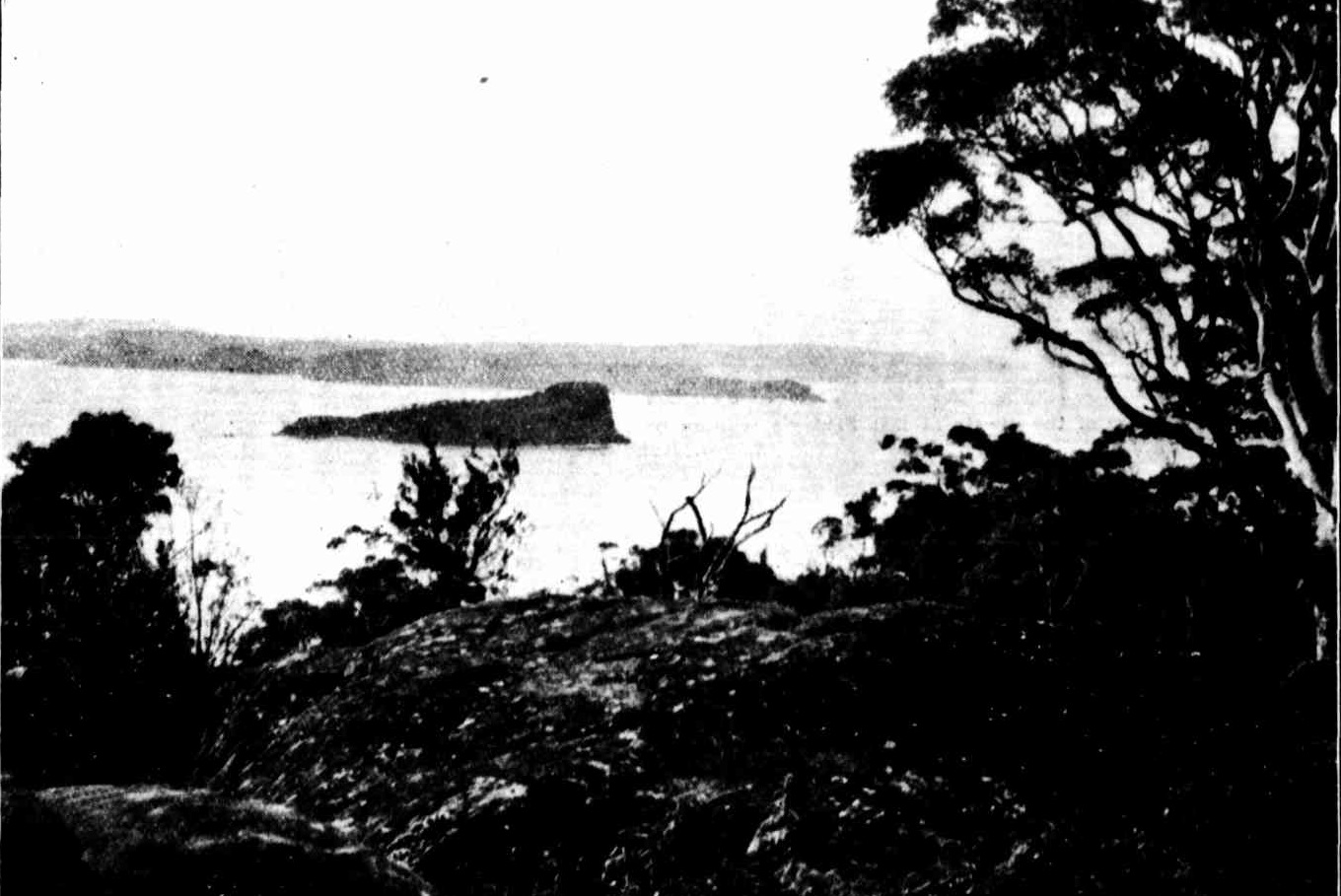
These rocky shores are a favourite haunt of our Boomerang Walking Club. LION ISLAND, AT THE MOUTH OF BROKEN BAY. (1933, November 22). Sydney Mail (NSW : 1912 - 1938), p. 47. Retrieved from http://nla.gov.au/nla.news-article165961286
For Queensland Readers a Boomerang Walking Club was formed for them too:
Boomerang Walkers
The annual meeting of the Boomerang Walking Club was held in the Young Women's Christian Association rooms, Adelaide Street. Miss Townson (president) occupied the chair. It was reported that enjoyable outings had been held to Seventeen Mile Rocks and upper reaches of the river, White's Hill, and Pine Mountain. Boomerang Walkers (1932, March 2). The Telegraph (Brisbane, Qld. : 1872 - 1947), p. 7 (FINAL). Retrieved from http://nla.gov.au/nla.news-article180053428
Her Readers and Letter Writers would share information about their own walks, including those taken here:
Cinderella' s Post Bag
MY DEAR CINDERELLA,— Wahroonga. It is such a long time since I last wrote to you that I thought I must drop you a line. At Christmas time we spent two glorious weeks at Narrabeen. The weather was ideal for surfing, so we made the most of it. I always had an idea that the surf was rather dangerous there, but only on two or three occasions we found the undertow strong. One day we hired a boat and went up Deep Creek. It was rather a hot day, and my arms got a bit sunburnt. On each side of the creek people had pitched their tents, and they looked so nice dotted here and there amongst the trees. People were bathing in the water, and we had to steer the boat in a zig-zag fashion practically all the way alone.
About half way up we pulled in towards the bank, and everybody hopped out to have a look round. After I having afternoon tea we started for home. My sister I took several snaps, and they came out very well. It was about five o'clock when we got back to the boatshed, and everybody said what a glorious day we had had.
Another day we walked up Deep Creek-road towards the Elanora Golf Links. After walking some distance we turned off the road, and climbed the hill. When we reached the top we were rewarded with a lovely view of Narrabeen Lakes. Walking further on we could seethe ocean and coastline. On reaching home everybody was feeling rather hungry, so we voted for an early tea. Our second long walk was from Narrabeen to Collaroy. Leaving the main road we went down a side street and then up a steep hill. Reaching the top we had a glorious view of the ocean, and could see all over Collaroy, and Narrabeen away in the distance. I enjoyed the holiday very much, but the two weeks went too quickly. Ruby Litchfield, my old correspondent, is quite well again. 'Darkie's' address is Carruchan, Kennedy, North Queensland, now. She still writes me nice long letters. Trusting you are quite well, and not forgetting Ali Baba. With love from 'CHERRY BLOSSOM' (O.I.).
(Dear 'Cherry Blossom,' — Like myself, most of our old brigade will be very much interested to see your name on the C.P, once more. I know Elanora as a place of very fine views, and you must have enjoyed your Narrabeen holiday very much. Thanks for sending me word of Ruby and 'Darkie,' to whom I owe a letter. — Cinderella.) Cinderella's Post Bag (1932, March 9). Sydney Mail (NSW : 1912 - 1938), p. 47. Retrieved from http://nla.gov.au/nla.news-article160081879
While Ella and her friends made frequent treks into Pittwater, gathering insights for her to share and inspire the Children with:
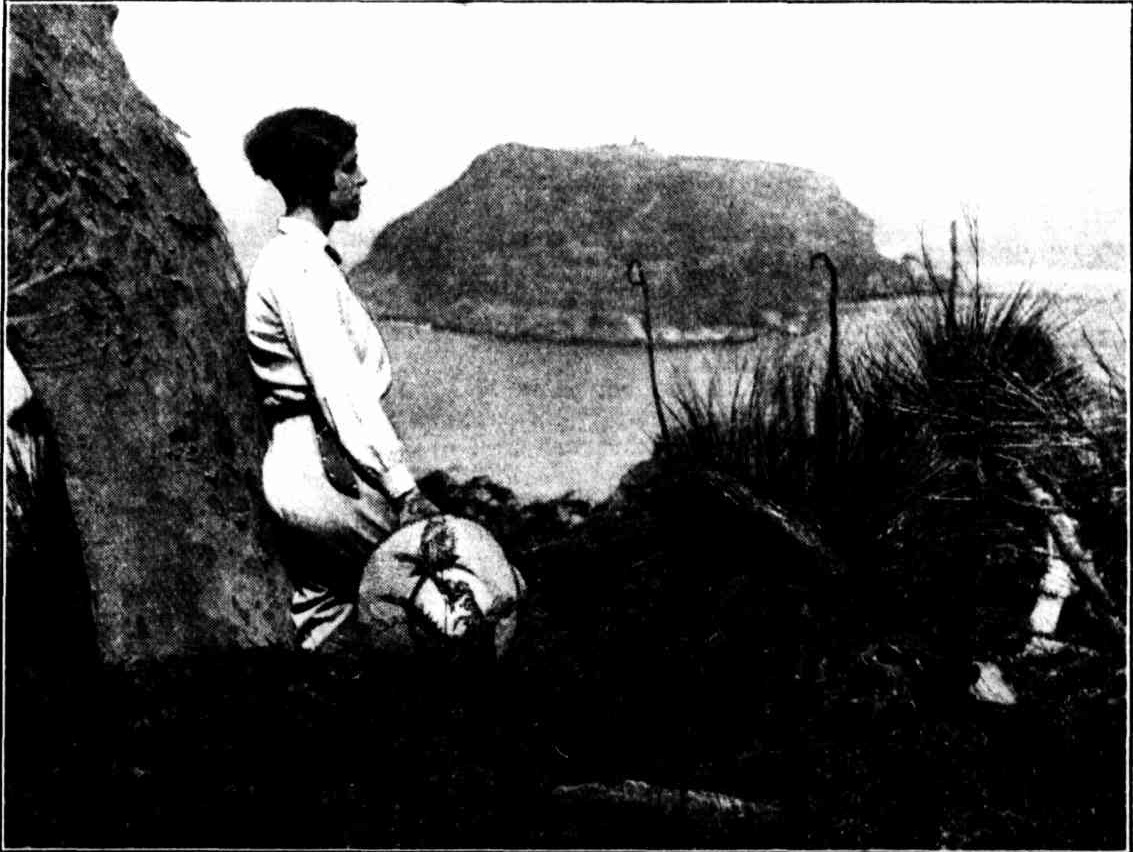
JEAN, Of the Boomerang Club. The picture was taken from the Pittwater shore, and shows Barrenjoey. Children's Page (1933, February 8). Sydney Mail (NSW : 1912 - 1938), p. 47. Retrieved from http://nla.gov.au/nla.news-article165958448
Boomerang Club Notes
By Number One.
OUR Easter walk from Gordon to Broken Bay added fresh laurels to those invisible wreaths that adorn our members' heads — their old felt hats notwithstanding. Cinderella had so little spare time at Easter that the walk had to be compressed between Sunday night' and Monday night. As speed was essential, only a small party likely to maintain an even pace was selected. To grade as a Boomerang one must, among other qualifications, be able to walk 20 miles in a day without serious fatigue. To graduate as Big Boomerang one must be able to face an emergency of 40 miles within 24 hours. Several senior members have possessed this qualification for years.
Starting from Gordon about 8 p.m., twelve moonlit miles brought us to our supper on a rocky site where uncontaminated water and plentiful firewood were available. The midnight march was resumed, despite a vivid electrical storm to seaward, and we lay down in the pre-dawn chill on our old camping ground at Elusive River. A camp-fire of redgum, a snack, and an hour or so of sleep under our coats, and we were off for the cliffs above Broken Bay and that lovely panorama of Hawkesbury River, the Bay, Brisbane Water, Pittwater, Lion Island, and the sunlit ocean, which we believe to be uneclipsed by any scene on the coast.
A hot breakfast, a doze, and a little loitering and we are back on Elusive River — which is only mapped as such by the cartographers of Fairyland — for lunch. Our last meal was at dusk, near country sadly desolated by road-making, and then with our backs to the bush it was the hard road under our feet again. The 'Secretary Bird' and 'Beetle' marched well and earned packs round about 20lb weight. 'Lilac Blossom' and 'Ashie' (a new recruit' from Queanbeyan, where 'Toad' has been training her) proved very stout fellas and finished swingingly at four miles an hour, making Gordon by 10.30 p.m. The mileage, irrespective of camp-making and rambling, was 20 miles of hard road and 26 of tracks, much of it cluttered with loose stone. The 46 miles total was a creditable performance — and everyone was able to get into city shoes and go to work next day.
Cinderella, will see her young friends every Tuesday morning between 10 and 12 at the 'Sydney Mail' Office, 'Herald' Building, Pitt and Hunter Streets. Business girls may call from 5 to 6.30 p.m. last Tuesday in each month. Cinderella's Page (1938, May 4). Sydney Mail (NSW : 1912 - 1938), p. 47. Retrieved from http://nla.gov.au/nla.news-article166227905
BOOMERANG CLUB.
ACTIVITIES of the Boomerang Walking Club have been slowed down by the fact that some of our senior boys are on active service, and many of our senior girls too busy with war work at week-ends to join outings. The Junior section, known as Greenwoods, are eager to carry on, but I have been obliged to limit walks in the interest of work for our J.R.C. Fair. Last week's walk was postponed while I made two little garments for children, finished a patchwork quilt, and made a bunch of needle-caps, which sell at sixpence a pair for our war funds. It was worthwhile missing a walk to get this done, when warm clothes for children and comforts for sick soldiers are so much needed. I hope some of you are planning to send something for the stall, and when that is over we will have bush days again.
How many of you could Join an all day walk for a Sunday in May? Distance from eight, to ten miles, and rather easy going, with bush cookery at our midday meal. BOOMERANG CLUB. (1941, April 23). The Sydney Morning Herald (NSW : 1842 - 1954), p. 28. Retrieved from http://nla.gov.au/nla.news-article17725251
The poems inspired along these walks ran in other publications - these are two shared previously about Pittwater and Broken Bay:
WEST HEAD
Happy it is in the blossom time,
In the blossom time of spring,
When the morn is in its golden prime
And birds are on the wing.
Blue of the tide upon either hand,
From the sea to Broken Bay,
And the grey old lichened boulders stand
Knee-deep in flow'ry spray.
Blithe at the heart for the wattle's sake,
And the scent the warm wind spills,
Where the Hawkesbury lies, a gleaming snake,
Amid the deep blue hills— ;
Stirring the bee's with their honeyed load
From the blossom feast beneath,
Happy it is to take the road
That winds across the heath.
ELLA MCFADYEN.
WEST HEAD. (1929, January 4). Windsor and Richmond Gazette (NSW : 1888 - 1954), p. 2. Retrieved from http://nla.gov.au/nla.news-article85927422
SANDS OF MORNING.
by Ella McFadyen.
Summer breathed over the hills to-day,
A waft of the bush and a wind from the bay,
And my truant thoughts went straying:
Pittwater flickered with nor'east flaws,
The surf ran high 'tween the Lion's paws,
And the spring-fed runnels' were playing.
I saw the hills that drop to the sea,
And a honey-bird's call was a call for me
And the great grey sandstone boulders
Were elephant's browsing, heath to the knees.
And the rosy waxflowers, clotted with bees,
Fondled their lichened shoulders.
To-morrow I'll rise and be ready to roam
In the starlit hour when the cats come home,
Ere ever the birds are waking,
When each needlewood thorn is a dewdrop's place,
And her thread-like blossoms are fairy lace,
And the whole world's mine for taking!
I must seek the lairs where I used to lie,
Curtained by trees and under the sky;
I must find and touch and recover
The sights and sensations laid away,
Where the Lion lies couchant at Broken Bay,
To welcome me back like a lover.
The strong white feet of the winter rains
Have trodden the campfire's cold remains,
The lizards my hearth are keeping;
I must find the cave where the fairy-mouse
And her wee pouched kindred kept their house,
And-the nest where her babes are sleeping.
Grape-blue the hills in the dawn shall be,
And the sun shall rise from a white-gold sea,
With light for the day's adorning,
Where the rain-washed track is a virgin sheet
For the printed tale of a pilgrim's feet;
My feet on the sands of morning.
SANDS OF MORNING. (1935, March 14). The Sydney Morning Herald (NSW : 1842 - 1954), p. 2 Supplement: Women's Supplement. Retrieved from http://nla.gov.au/nla.news-article17171195
That this place was a solace and refuge to Ella and her friends is threaded through all her works. Even decades later she recalls her visits here as visions. Her interview with Hazel de Berg marks pointedly the great beauty of the Australia as experienced in her many bushwalks, and one particularly long bush walk from Gordon, a Sydney suburb to the coast here and back. The bush walk started at 3am and finished at 11 pm and covered 42 miles. Ella remarks that her bush walking friends relished the experience.
In December 1938 the Sydney Mail’s last Issue ran. There is a slight tone of lament in ‘Cinderella’s’ farewell, (even though a new page would commence in January 1939 in the Sydney Morning Herald), and this may be because the Sydney Mail was published as a weekly journal for country Readers, for rural and bush places, where so much of what was run, was enriched and inspired, and rang true in the very essence of Ella sprang from.
The world she had been born into was vastly changed by the 1930’s – even her beloved Pittwater was experiencing a building boom. And even though the Ku-Ring-Gai Chase National Park was there, and remains so, and there were paddocks still between the holiday villas and homes of year round residents, the masses of waratahs were disappearing from the eastern hills of Palm Beach and all bushlands south to Manly, and the quick bounding 'thud thud' sound through the bush of a soft padded wallaby or the call of a koala from the trees above, were not as frequent as they had been before.
Her farewell:
Cinderella's Page
Farewell, Old Days
Dear boys and girls,— And all friends who have kept the C.P. way with me, we have come to the end of a chapter, at the end of a day at the end of a year. When the sun rises on 1939 there will be no more 'Sydney Mail.'
But let us look forward. Changes have to come. Kipling said: 'All new things are sorrow,' and that is true of them at the first. But a seed has to fall before a new plant can grow. In the Big Scrub (where some of us have rambled together — remember?) on the slopes of the Rain Forest, when a great tree goes down with a crash it rends the green twilight and lets in the sky. Then things that needed the sun-light come to life and thrive, for the fertile soil has been waiting. If we keep our minds and hearts fertile with the old seed the C.P. has sown (you won't forget the 'Seed Plots,' will you?) then there will be friendship, loyalty, courage, gaiety, abounding interest in all the things we have ever loved, just waiting for that chance of new growth — the coming of the New Thing that is at first sorrow, but afterwards reveals the face of opportunity.
The Old Days Together
MY mind is crowded with pictures as I write. The tea-table at the party Alison Fraser gave when the C.P. was one year old, and I cut a cake with one candle and they gave me a little brooch I have always treasured, the fairy slipper in enamel against a heart rimmed with pearls. The boys and girls round the table that day are men and women now. . . . Wagga on a race day, flying cars filling the air with gold of suspended mica dust, against the green curtain of willows round Wollundry Lagoon, floored with azolla-weed turning from pale green to rosy red. Four little girls are with me, discussing the mystery of a parrot's egg we have found, and planning to give it to a certain long-suffering duck to hatch. The youngest little girl — the one who got excited and broke the egg — takes up an appointment at a great school in Armidale next year.
'MAC' and 'Macnore' are steering us round the bends of the Black Scrub track above Nerang, through a mountain mist that fills the Numinbah Valley almost to the top of the ragged hoop-pines by the roadside edge. 'First Correspondent' is with me on that Queensland holiday, and — had we known it — among the bags and bridles and the saddle and the tired drover's dog in the back seat, Cupid is tucked out of sight — a stowaway. . . . Tramping with Ben through Ten-Mile Hollow of a rainy midnight. How tall the red gymeah lilies were that spring, when we had waded the Mangrove Creek flood and climbed over Penang Moun-tain. . . . Marching with 'Toad' over Berry Mountain by the full moon, the weariness of 56 non-stop miles in our boots. 'Secretary Bird' came to our hotel next morning to see if we were alive and brought us Bundywalla oranges. Paterson River grows none sweeter.
SCRAMBLING for wildflower photographs with 'Mac' of the Boomerangs (not the former 'Mac') up the steepest trig. stations of the North Shore. . . . Camping out for New Year on Elusive River . . . groping out of Moss Vale in a black mist with 'Abeg-weit' at three of the morning, to spend the noon catching frogs below Fitzroy Falls. Tramping from Lindfield to Barrenjoey under the Easter moon all night, by the cliff road above the league-long loops of silvered surf. ... A tea with 'Puzzle' in a Melbourne tea-shop, when 'D.D.' was there. Now 'D.D.' has a name listed by book clubs and lives in Libya. 'Pandora,' who scrambled over Cambewarra hillsides with me, wrote last mail of rogue elephants in the Nilgiri Hills, India.
A WESTERN sunset shared with 'Mirran,' putting the car over the grassy flat to pick up motherless lambs, for the merinos had twins that year and no merino ewe can count above one. . . . Trudging from Tunglebung to Tabulam through rain that put 15 feet into the Clarence River, and Marjorie and I fighting off the young cattle that tried to ring us the whole three miles of the cut-road by the river. I rush the Kerrys, toreador-fashion, with a whirling rain-cape, and Marjorie, whose faith is grounded on a rock, stones the stubborn Herefords, and at length, wet and breath-less, we dash into the Rectory, and are received without a qualm and given tea and bread-and-honey by the fire.
A BLACK velvet night under the palms at Soraken, with moonlight insets patterning all the long perspective of the plantation floor. 'Bing Boy' is talking over his plans and the fireflies are flitting in the fern. . . . The day on Bungeroo Creek when I killed my first death adder with a sheath-knife and made a song about it. . . . A camp-fire 'Beetle' and I kept going one night of pouring rain. . . . The long room at Cooerwull House, looking out on the old stone mill, when we knitted and knitted and the plan for our Red Cross quilts was born. Jean Wetherall, such a little girl, coming to Warwick Building to pay the first personal visit of any C.P. member. I 'visited' Jean the other day when she turned on a radio talk and heard my voice in her own home. ... A day with 'Stout Fella' at Auchenflower. .... Feeding wallabies at Jenolan Caves. . . . Eating pawpaws atop of Kieta Hill. . . . The gecko who crawled into my camp-bed above the old Joadja Shale Mine. . . .

OUR HOSTESS, BUNDYWALLA — Snapshot by 'The Secretary Bird.' This old lady, one of the early settlers at Bundywalla, near Berry, entertained our Boomerang Club royally when we visited the district. Her home, typical of the old days, is hidden under the three pines to the left of the picture, in middle distance.
.jpg?timestamp=1579133334368)
PETER AT THE WHEEL.
A last scene — the bush cave where we gathered a few evenings since. Friends with a wireless installation for their car brought us my little Christmas play, 'The Road to Bethlehem,' over the air. Then we had tea and the girls gave me a lovely pair of silken cushions subscribed by many and made by the clever fingers of 'Glass Slipper.' And we finished with 'Auld Lang Syne.' . . . Eighteen happy years that we could wish would go on and on, but that, as Browning reminds us,
A man's reach should exceed his grasp , or what's a heaven for?
Hail to the New!
DO this for me: Write to me, happy letters if you can, all about our old page and the things we have loved together, and about yourselves and your plans— just once more. I shall not be able to reply individually, but I want those letters to put in a big file for a treasure that I may keep. If you write on only one side of the paper it will be easier to file them.
And now Cinderella begins a new page on Thursday, January 5. You will find it in the Retail Section of the 'Sydney Morning Herald' on that day. Come to me, old friends, and let us make the new page as happy as the old. — Cinderella. Cinderella's Page (1938, December 28). Sydney Mail (NSW : 1912 - 1938), p. 47. Retrieved from http://nla.gov.au/nla.news-article166525375
The story behind the story here, according to Ella, as stated in her interview with Hazel de Berg, was that with WWII brewing, and Fairfax not wishing to invest in the new printing equipment, the 'Sydney Mail' was closed. There was not as much space dedicated for children's missives and her answers in the Sydney Morning Herald, however, Ella was also making recordings of her stories for radio and writing for other periodicals:
MRS. PEG AND DANDY AND NOBBY.
There will be thousands, particularly among the young people, who will learn with special pleasure that Miss Ella McFadyen, nature student, poet and fairy story teller, is again on the air. Her page in the late-lamented "Sydney Mail" made her a multitude of friends throughout New South Wales and Queensland among old and young. Now her "Pegman" series is being presented by radio to very young listeners every Tuesday and Thursday evening in Tiny Tots session. It will be a popular feature for sure. No child could realise how alive clothes pegs can be until they have listened to Miss McFadyen's "Pegman" fairy stories. Tuesday and Thursday 5.20 p.m. MRS. PEG AND DANDY AND NOBBY. (1939, April 25). Macleay Argus (Kempsey, NSW : 1885 - 1907; 1909 - 1910; 1912 - 1913; 1915 - 1916; 1918 - 1954), p. 2. Retrieved from http://nla.gov.au/nla.news-article234330253
She also was involved in war work:
JEAN BRANSDON, a member of the Boomerang Club, whose hobbies are natural history, photography, bushwalking, and camping. Jean has done some notable long-distance tramps with the Boomerangs and other groups.
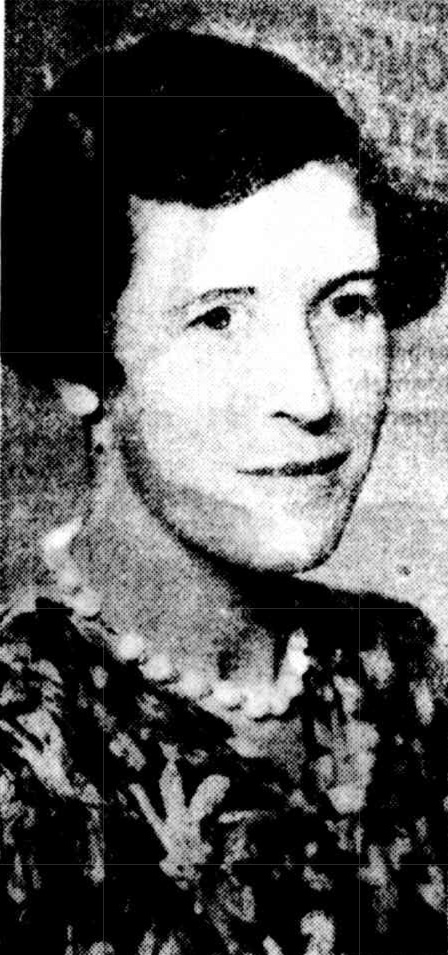
JEAN BRANSDON (Wollstonecraft) joined Elma Williams in Melbourne, and the girls toured Tasmania from Launceston, down the East Coast from St. Helens, and spent five days in camp at Lake St. Clair, where snow fell around their tent. Jean's snap-shots at Port Arthur and Eaglehawk Neck were highly successful, but abundant rain hindered camera work elsewhere. PROMENADE (1940, February 15). The Sydney Morning Herald (NSW : 1842 - 1954), p. 24. Retrieved from http://nla.gov.au/nla.news-article17671903
STITCH IN TIME.
It was Jean Bransdon (of our Boomerang Club) who suggested I go with her and her sister Anne to Middle Head Fort, where the Business Girls' Voluntary Service give Saturday morning aid to sew for the men in garrison. Betty Pryor, Olwen Thomas, and Win Watson are also Saturday helpers there, while a Friday group, expert in re-tailoring uniforms, works, under the supervision of Miss Shugg. We let out seams, took up sleeves, shifted or replaced buttons, and generally pressed and repaired the garments brought to us, and at midday dined (on army stew), with the Sergeants' Mess.
Other groups of the B.G.V.S. do similar work at Warwick Farm, Ingleburn. Walgrove, and Marrickville Drill Hall, while at the Showground they give clerical service in the evenings. Twelve of their number, are now learning to make camouflage nets in order to act as instructors to a waiting group of girls, who will give up their evenings and Saturday leisure to this urgent work.
ANNE BRANSDON, supervisor of the Saturday Group of the Business Girls' Voluntary Service, who make sewing repairs for the garrison at Middle Head. STITCH IN TIME. (1941, June 5). The Sydney Morning Herald (NSW : 1842 - 1954), p. 20. Retrieved from http://nla.gov.au/nla.news-article17743467
A Literary Life
As noted above, Ella was one of the original members of the Society of Women Writers NSW, formed in September 1925. Women were beginning to have more independence during the 'Roaring 20's - as noted in this rural newspaper - they were not restricted to their traditional roles:
Women Come into Their Own
Women are fast coming into their own, and proving that they can hold their own with the best of them. The lady member of the N.S.W. Legislative Assembly, Miss Preston Stanley has made her maiden speech and tho House decided it. is an acquisition.
Miss Stanley possesses a fertile brain, and long experience makes her at home in addressing any big gathering, so when she had before her an audience, mostly men, with just a limited number of ladies, she was never at a loss. She told the Assembly that in the old days when she watched Parliament from one of the galleries she used to wonder how so many 'old women' used to get into it, which goes to prove she is not lacking in observation.
Women are playing an important part in the world of journalism just now, and quite a number of them are delegates at the Empire Press Conference which is to be held in Melbourne it the end of the month. They are recognised as authorities on numerous matters, and many positions of note are held by them. As one writer points out, ''It is not. so long since the first chronicles of social happenings in the columns of an English newspaper.
Some of the younger generation can remember when the more important and exclusive of the journals opened their pages to women contributors on dress and fashion. Now press women ' stand on their own and the work which they accomplish Is well worthy of the papers of which they are valued members of the staff.'' Women Come into Their Own (1925, September 5). The Bathurst Times (NSW : 1909 - 1925), p. 7. Retrieved from http://nla.gov.au/nla.news-article118035435
Millicent Preston-Stanley was an Australian feminist, and politician who was the first female member of the New South Wales Legislative Assembly. In 1925 she became the second woman to enter government in Australia, representing the Eastern Suburbs as a member of the Nationalist Party, one of the historic predecessor parties to today's Liberal Party. After a failed bid in the 1921 election she persevered and picked the seat up in May 1925, and held the seat until September 1927.
The Empire Press Conference should not be underestimated in its 'forwarding of women's roles outside nurse, secretary etc. Of course - what happens when you get like minded women together to listen to others and talk with each other on what interests them? They figure out how to work together for the betterment of all. Especially when prefaced by:
WOMEN'S WORLD
Conducted by 'HOUSEWIFE '
Women and Journalism
Women are playing a very important part in the world of journalism just now. They are recognised as authorities on numerous matters and many positions of note are open, to them. Several women are included among the delegates to the Imperial Press Congress.
IT is not so very long since the first chronicling of a social happening in the columns of an English newspaper. Even some of the younger generation can remember when the more important and exclusive of the journals opened their pages to women contributors on dress and fashion. Now presswomen stand 'on their own', as it were, and the work which many of them accomplish is well worthy of the papers on the staffs of which they are valued members.
Take, for example, Mrs. A. Moore. She comes to us as delegate, and not merely as the wife of one. Under the euphonious pseudonym of 'Eve Adam' she represents the Sheffield 'Daily Telegraph,' the 'Review of Reviews.' and 'T.P.'s Weekly.' She has had wonderful experiences of political journalism in Persia, Mesopotamia, and' in the Balkans, as well as in Russia under both Tsarist and Soviet rules: while in 1913 she was on the staff of the Russian supplement of 'The Times.'
Mrs. Moore had indeed a stirring time just at the outbreak of the war, as she just managed to escape, from Belgrade on the night of October 7, 1915, just after the Germans had occupied the town. After, working with Sir Arthur P.-.gel, the Red Cross Commissioner at Nisch, she retreated with his party, almost the whole way on foot, as far as Mitrovitza, afterwards arriving at Salonika with the British Naval Mission. From Serbia she contributed to the 'Daily Chronicle,' and in other ways she has played a most important part in journalistic circles.
To read of the doings of a woman of this kind makes one realise what a wonderful part many of them played during the lime and stress of war. Mrs. Moore has just completed a volume dealing with celebrities of the Victorian era.
THE heartiest welcome is now being extended to the women of the Imperial Press party by the women of Sydney, both journalists and others. It will be found a liberal education lo talk to some of the visitors and to realise what they have done to raise the standard of women's work on the press. Mrs. Benson Infield, for instance, is a woman of many parts, and amongst her varied interests she is a director of the Southern Publishing Company, Ltd., of England. This naturally brings her into touch with all manner of interesting people. She is interested in half-a-dozen or more schemes, including the running of several hospitals, their success pointing to her business acumen. During the war she kept open house at Brighton for New Zealand soldiers, as some of her early life was spent in the South Island of the Dominion.
The wives of several of the delegates are filling important posts in the journalistic world, notably Viscountess Burnham, who is the president of the Society of Women Journalists in London. Referring to women and their work in the newspaper world, a well-known English writer (Sarah A. Tooley) says:
-—'In continuing our view of the entrance of women into trades and professions hitherto followed almost exclusively by men, journalism may be cited on account of the great increase during recent, decades of women writers for the public press. They have a wide field for specalisation. Never have women's home topics occupied so large a space as they do in the newspapers of to-day, or been treated in so practical and artistic a manner. To the old subjects of dress, the toilet, cookery and housekeeping, which appeared in the bygone miscellanies For my lady's boudoir, are added sport, philanthropy, social and political work, news of movements and essays to voice women's ideals and their newly awakened aspirations. Women are of necessity on the staff of every paper to meet new demands, and some hold editorial positions and have founded periodicals.

.jpg?timestamp=1580261036739)
.jpg?timestamp=1580261055797)
.jpg?timestamp=1580261100749)
1. MRS. H. HORTON, wife of Mr. Henry Horton, of New Zealand. Her husband is the principal proprietor of two of the oldest-established papers in the Dominion. Mrs. Horton is a prominent worker in women's causes.
2. LADY VIOLET ASTOR, wife of Major the Hon. J. J. Astor, M.P., chairman of 'The Times'' company, London. She was married in 1916, and has three sons. She is the youngest daughter of the Earl of Minto.
3. LADY NEWNES, wife of Sir Frank Newnes, Bart., who controls so many of those papers in which women take the keenest interest. Lady Newnes is a daughter of the late Sir Albert de Rutzen, and was married in 1913.
4. MRS. CADBURY, wife of Air. Henry T. Cadbury, who is identified with the 'Daily News,' which was established by Charles Dickens in 1846.
5. LADY FENWICK, wife of Sir George . Fenwick, managing director of ' the 'Otago Daily Times' and 'Otago Witness,'': published in' Dunedin. She has lived in a journalistic atmosphere ever since her marriage. She is an active worker in all philanthropic movements in New Zealand. 6. LADY DAVIES, wife of Sir William Davies. She has all her interests in Cardiff, Wales, where she was born, but she has travelled extensively in Europe.
7. LADY CARR wife of Sir Kinsley Carr, director of the well known publishing line of George NewiieS, Ltd. She is the eldest daughter of the founder of the ''Western Mail,' and has, therefore, been brought up in journalistic circles.
8. MISS ILLIFFE, daughter of Sir Edward Iliffe, MP, who is accompanying her lather.
9. MRS. LEYS, wife of .Mr. W. Leys, editor of the 'Auckland Star.''
10. MISS M. J. GRAHAM, daughter of Mr. and Mrs. N. H. (.'rnhjin. whom she is accompanying on their overseas visit.
11. MRS. N. B. GRAHAM. wife of Mr. Norval Buntock Graham, the owner of several provincial newspapers in England. .Mrs. Graham is very interested in journalistic work.
The first women's daily paper was 'La Fronde,' founded in Paris by Madame Durant about 1897, and it was edited and written exclusively by women. IN China several papers have been written and edited by Chinese women, notably the 'Pekin Women's Paper,' which was edited by Mrs. Chang, one of the most remarkable women of her times. In Norway Miss Gina Krog founded 'Ny-jlaende,' the Norwegian women's paper, while there are at the moment women's papers flourishing all over the world. That women have triumphed in the journalistic sphere cannot be denied, and the work of Harriet Martineau and Frances Power Cobbe as leader-writers of a London daily will ever stand as a memorial to their ability and enterprise. It has to be remembered that women were not accepted some years back in such work without a good deal of suspicion. These have blazed the trail for their sisters to follow, and to-day women of the right type find a welcome waiting for them on the big newspapers. Indeed, if a woman be reliable, accurate, and enterprising she will be considered a valued member on any newspaper staff, and will grow grey in the service, provided, of course, that she still retains her spirit of enthusiasm and youth and is ready to march with the times.
Mrs. Emily Crawford is said to have been the first woman 'to hold a staff appointment of front rank as foreign correspondent for a daily paper. Her work in this department for several papers simultaneously is a brilliant record in the annals of journalism. It is said that the stirring, fascinating drama of the French capital was an open book to her for nearly a lifetime. She had danced at the Tuileries and witnessed the terrors of the siege of Paris and the Commune. One of her most brilliant journalistic feats was gaining admittance to the seances held in the French Parliament at Versailles immediately after the Franco-Prussian war and reporting the speeches from memory, notes were not permitted to be taken. She often sat for seven hours during the momentous debates. Mrs. Crawford's work was acknowledged by the French Government with the offer of the Legion of Honour, but she refused the distinction for herself, requesting that it might be given to her son.
AND so we welcome to-day those women who have come into our midst either as delegates to this important Press Conference or as the wives of those men who have come officially for the great event. Much interest attaches to Lady Violet Astor, the youngest daughter of the Earl of Minto. She takes a great deal of pleasure in acquainting herself with the overseas Empire, as her father was both Governor-General of Canada and Viceroy of India. She is a keen horsewoman, a rider to hounds, and an. excellent -angler. She also interests herself in social welfare matters pertaining 'to .women and children. Lady Apsley, who is accompanying lier husband, being at present with him in the Northern Territory, has been married only a year. Lady Carr, wife of Sir Emsley Carr, is also interested in welfare work, and takes a leading part in the management for Schools for Mothers, in South London.
Finally, there is Lady Davies, of Cardiff, Wales, who had given much of her time to social, philanthropic, and public movements. To them all the women of Sydney extend the hand of friendship. Many entertainments have been arranged in their honour. This morning a civic reception will be held at the Sydney Town Hall. In the afternoon' the. Governor and Lady de Chair will be 'at home' at the State Government House.
Other entertainments include a reception at the University on Thursday afternoon, and on Saturday the visitors will be entertained at a harbour .excursion by the Institute of Journalists. In the evening the delegates will be the guests of the chairman of the Australian section of the Empire Press Union (Mr. J. 0. Fairfax) and Mrs. Fairfax at their home, Fairwater, Double Bay. All we need is fine weather to impress our visitors. Let us hope that sunny New South Wales will live up to her reputation. Women's World (1925, September 2). Sydney Mail (NSW : 1912 - 1938), p. 27. Retrieved from http://nla.gov.au/nla.news-article160084482
ENTERTAINED BY WRITERS
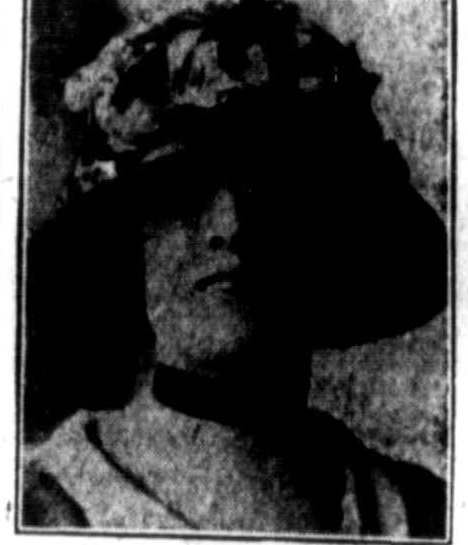
Lady Burnham, who was entertained by the Society of Women Writers at the Hotel Australia this morning. —Photo, by Monte-Luke. FOR WOMEN (1925, September 26). Evening News (Sydney, NSW : 1869 - 1931), p. 8. Retrieved from http://nla.gov.au/nla.news-article116065702
The first President of the NSW Society of Women Writers writes in October:
WOMEN'S COLUMN.
WOMEN WRITERS.
(BY FLORENCE BAVERSTOCK.)
As reported from Melbourne, Lady Burnham, during tho proceedings of the Press Conference, gave a most interesting account of English women Journalists and of the operations of the Society of Women Journalists, of which Viscountess Burnham herself is president. The Society exists to further in every likely way the interests of women who earn their living by their pen, and among the practical benefits available to members of the society are the services of an oculist, a physician, and a legal adviser, all of whom may be consulted without fee. Lady Burnham declared herself quite confident that her society was doing excellent work In the profession, and that members found it to be greatly to their advantage to belong to it. The status of presswomen, among other results, has been raised, and a fine spirit of comradeship has been developed among those workers in what is, after all, one of the most modern of the ways in which women earn their living.
To strike while the iron is hot means doing a thing at the right moment. Several women writers here felt that Lady Burnham's presence in Sydney was the time to form a society of the kind indicated above, and to ask the president of the English society to meet the promoters of the scheme, and to give our infant steps those lucky words which from the most ancient days until now have always been considered the conveyers of peace and prosperity. Lady Burnham wished the Society of Women Writers the best of luck in very cordial terms, and advised that all sisters of the pen wore in the right track in joining up into an entity which must be for the great benefit of all.
So this new organisation of Women has had an auspicious start, and everything points to a long and useful career. Viscountess Burnham and Mrs. Henson Infield, who also cordially agreed that such a society was dostlnod to benefit one and all who belong to It, consented to become the first life members of this association, which spreads a net with a finer mesh than the London Society of Women journalists, Inasmuch as many of the leading writers of stories, nature studies, and verse have joined its ranks. This Inclusion makes for a larger and more influential membership roll, and shows that spirit of unity animates all travellers by the various routes which lead to publication, whether they use the humble paths of the youthful reporter who describes a "very pretty wedding," or the higher walk of the verse writer who can produce lines with a thrill in them; of the woman who can tell a story that will move, and of the-nature student who brings all out-of-doors before us.
With a membership of over 80 names (which Lady Burnham thought "splendid"), the new society promises well, and another encourag-ing fact is that women of all ages have Joined. Very valuable will be tbo acquisition of so many young fresh minds with their bright intelligence and eager outlook on life. The older women can often help such with their experience and counsel. It is to the girls we must look to keep up the prestige of the profession of the pen, and that they are capable of doing it there can be no question. To belong to a regularly constituted coterie of workers with similar aims must help all and raise the statue of each member. In no sense a club, of which there are several useful and excellent examples already in Sydney, the new Society of Women Writers makes strong appeal to the spirit of comradeship already a growing factor among women doing similar work. WOMEN'S COLUMN. WOMEN WRITERS. (1925, October 17). The Sydney Morning Herald (NSW : 1842 - 1954), p. 10. Retrieved from http://nla.gov.au/nla.news-article16248987
From the outset Ella's work was noticed - Australia wide - she had such a clear, distinct voice:
ANOTHER AUSTRALIAN POETESS.
"Outland Born," and other verses, by Ella McFadven; Australian Authors' Agency, Melbourne.—This minor poet brings good credentials, for in republishing her fugitive verse she acknowledges indebtedness to editors near and far. She has a wealth of imagery, a fertile fancy, much technical skill, and in particular a virility which recalls Miss M. E. Nesbitt rather than the usual type of woman artist:—
He little loved—the wise old king,
To think on me, his heir,
I doubt me if he grudges now,
Who sleeps so silent there.
The crown that clips so close my brow.
The high, engilded chair.
Te dragged me from my quiet dreams
Of studentship and art;
Te thrust a sceptre in my hand—
I pray you steel my heart:
-put words of wisdom in my mouth.
That I may speak my part.
The old king's hands lie crossed and cold—
The new king wears his ring: , The kneeling masses stoop and sway,
The smoking censere swing:
Te pray for him who sleepeth sound— !
Nay, pray ye for the King!
The distinctively Australian verses contain one obvious, but pleasant, echo of Kendall:—
I wonder if in later days,
When sullen winter lowers.
Will we discover them with hands
Still filled with summer flowers ?
Oh, if within the virgin hush
Of some untrodden glen,
Our stolen hours immortal wait
To welcome us again
The scenes of Nature imagined, here are somewhat alien to the Adelaide mind. The red lantana flames along the dusty highway, the hillside is head-high with rustling cane, and the "bungalow" is either a misprint or a tree. "Lawyer-latticed twilight, if set in an examination paper, would probably plough many. Doubtless it refers to a dense growth of clinging scrub._ (But why that particular climbing plant is called a "lawyer" shall, in respect for the feelings of the legal profession, be enquired into no further!)
The author shows a creditable desire to enshrine Australian place-names in her verse, but they are not always graceful—"along the Howlong Hill," for example. Even the native names in the East are not euphonious, like Kapunda and Onkaparinga; there is a fine bit of word painting about "amethystine ecstasy across the still lagoon," but it is from "the Woy Woy lights" that the radiance comes. Perhaps Ella McFadyen's best work is the Kipling-like close of the ballad of the Pioneers (Botany Bay type):—.
We were first, then wherefore least?
From our-graceless biers,
Like a death's bead at your feet
It is the pioneers.
By our right of elder days,
By our toil and thirst.
By our hunger, by dispraise—
Branded and accursed—
By the fields our children till.
Won with toil of ours,
By the homestead on the hill.
Nestled in its flowers.
By the tokens broadcast sown
Over Sydneyside,
By the weary walls of stone.
Lying north-by Ryde.
By the bitter tracks we trod,
By our exiled years,
By our six-foot grant of sod,
We be pioneers.
ANOTHER AUSTRALIAN POETESS. (1911, December 9). Observer (Adelaide, SA : 1905 - 1931), p. 6. Retrieved from http://nla.gov.au/nla.news-article164740663
In 1911 the following 'Peg Man' poem was published - this was a game Ella and her brother used to play with their cousins on the banks of Macquarie River in those eras where children made their own toys and amusements:
THE PEGMEN.
BY ELLA M'FADYEN.
We made the Pegmen all ourselves
From some of mother's pegs,
With little bits of kindling wood
Tacked on for arms and legs.
We made them in the summertime,
When days are long for play,
And lesson hours are early done.
And Cliff came up to stay.
We made them tools of wood and tin,
To help their farm to keep,
We built them dams and shearing sheds,
And paddocks for their sheep.
Cliff made them crooked roads, where they
Could ride their wooden horse,
And where be scooped a gully out,
He made a bridge across.
I built the woolshed and the gates
With sticks and things I got,
And Dorry, though she's just a girl,
She helped us quite a lot.
Cliff begged some oilcloth for their boots
(Although they have no feet), '
And Dorry helped to make their clothes,
Because she sews so neat.
From here to Pegmen's run, you know
Is quite a longish way,
Across the paddock, where the ram
Chased Cliff and me one day,
It's lonely there when evening comes'.
Because the river moans,
And makes a little saddish sound
Among the crossing stones.
They aren't afraid. They work all day,
As honest Pegmen should,
Their hearts are oak, although their heads
Are only clothes-peg wood.
And then we water all the roads
Outside the Pegmen's run,
And send them racing through the mud—
Oh, that's what I call fun.
And if they tumble in the creek,
You simply fish them out —
They aren't like silly dolls you buy,
That people scold about.
So if you get the kindling wood,
With which the fires are lit, -
And ask your mummy for the pegs
As soon as they are split;
And if she's got some oilcloth left
From covering her shelves,
Why, then, perhaps you'd like to make
Some Pegmen for yourselves.
For if you live away from town,
And want to have some fun,
There's nothing half as good, you'll find
As games on Pegmen's run.
THE PEGMEN. (1911, September 13). The Sydney Mail and New South Wales Advertiser (NSW : 1871 - 1912), p. 44. Retrieved from http://nla.gov.au/nla.news-article164333162
These stories, begun decades before, would grow with more 'chapters' added, which were first run in newspapers and eventually led to them being published as very popular children's books with wonderful illustrations. The Pegmen Tales (1946) and Pegmen Go Walkabout (1947) and Little Dragons of the Never Never (1947), featured the adventures of two little horned dragons from the centre of Australia. Ella even had these lizards as pets and became so good at looking after them and other Australian lizards both Taronga Zoo and the Australian Museum sent several to her for care. As such, Ella was an early wildlife carer:
TAMING THE LIZARDS
Miss Ella McFndyon has a flair' for winning the confidence of wild creatures of the bush. She has even managed to tame and to breed the tiniest of lizards. At the request of the authorities of Sydney Zoo, Miss MacFadyen has made a special study of that innocent and harmless little creature, with the fierce guise and the alarming name, the Horned Dragon. This, by the way, is .the least libelous of of its names, for in Latin it is Moloch horridus, and in bush English it is Mountain Devil, Demon Lizard, and anything else ugly that its appearance seems to suggest. Miss McFadyen will talk of 'The Horned Dragons of the Never Never,' from 2FC at, 10.45 — 'Women's Session' — on Wednesday morning next, and the talk will be relayed to 2NC, 2NB, 2CR. Therefore country folk may be sure of .being able to hear Miss McFadyen's story. TAMING THE LIZARDS (1937, September 11). The Northern Champion (Taree, NSW : 1913 - 1954), p. 8. Retrieved from http://nla.gov.au/nla.news-article162159928
DELEGATE FROM LIZARD LAND
By ELLA McFADYEN
WHEN Chips, the Horned Dragon from the Never Never, reached me after his long overland journey, he was just six and a half inches of sad little lizard, thirsty and troubled from his horned head to the tip of his thorny tail. Caring for these desert lizards, when they are sick or unhappy, calls for special knowledge and a lot of attention, so Chips was sent to me to grow well again.
With the right care he was soon enjoying his bath, sunbake and meals, and putting on frequent changes of colour-bright yellow, earthy red, or lichen-green, as these little dandies of our sandy inland do, if they are in good health.
When I took Chips to the Junior Red Cross camp, as living material for our nature talks, I hardly expected that he would be elected camp mascot. Maybe it was the Bathurst air, or perhaps the tiny black ants on Mount Panorama were especially tasty, but he breakfasted heartily, and then spent the better part of each day in charming the young campers to a kindly interest in our harmless Australian lizards. These inoffensive creatures are too often hunted or killed, though they are most helpful in eating harmful insects. DELEGATE FROM LIZARD LAND (1947, January 29). The Sydney Morning Herald (NSW : 1842 - 1954), p. 4 (Playtime). Retrieved from http://nla.gov.au/nla.news-article27905983
What stands out about her books is they are still being enjoyed by youngsters today - when you can get your hands on a copy.
Pegman story available online: New South Wales. Department of Education. (August 1948). The school magazine of literature for our boys and girls Retrieved from http://nla.gov.au/nla.obj-775758110
WHY BABY REPTILES QUARREL
By ELLA McFADYEN
"NATURE has a reason- for everything. It is fascinating to find out why animals do certain things.
Some creatures, like sea-birds for instance, live together in large colonies, and others, like deer and wild cattle and wild horses, form large family groups under one leader, stronger and wiser and bolder than the rest. As a rule, however, Nature finds it better for her wild families to split up. Even with the herd animals just mentioned, there comes a time when the old leader is too feeble or too cranky for the good of the mob, and then a young fellow starts up, fights and defeats him, and takes on the leadership.
One reason why all the little animals of a family do not stay together is that an enemy might kill them all in one attack. If they have scattered, some are sure to escape. But the chief reason why families break up and go different ways is that Nature insists that young animals learn to do their own hunting, instead of depending too long on their parents.
Savage animals, like lions and tigers, turn against each other as they become older. You never find a family living together once it has grown up. "
Among sea creatures, like the oyster, tides and currents carry the eggs here and there. The creatures that bore into piles and damage wharves, or attach themselves to ships, are another example of Nature's plans for scattering the young. Before they are full-grown, their bodies have limbs for swimming, but as soon as they make fast to a place that suits t hem, they change and become borers, or adapt themselves for sticking.
Many of our harmless, peace loving lizards have children who spend their early life quarrelling. The Big Skinks, like the Blue-tongue, the Pink-tongue, and the Giant Skink or Land Mullet, soon become so gentle as pets that they will take food from your hand. But they have big appetites, and their legs do not keep pace with their growth, so it is only as youngsters that they scamper about much. That is the best time for them to travel. And that is the time when you will see them snatching food from each other and nipping each other's paws.
This, pretty little striped skink is a finger-length of baby Pink-tongue, about a fortnight old.
In the Nature article In "Playtime" on July 16, the word "gills" was inadvertently substituted for "plates." The sentence in question should read: "Instead of scales, they have bony plates, called denticles, embedded In their tough skins." WHY BABY REPTILES QUARREL (1947, July 30). The Sydney Morning Herald (NSW : 1842 - 1954), p. 5 (Playtime). Retrieved from http://nla.gov.au/nla.news-article18037323
Some covers:

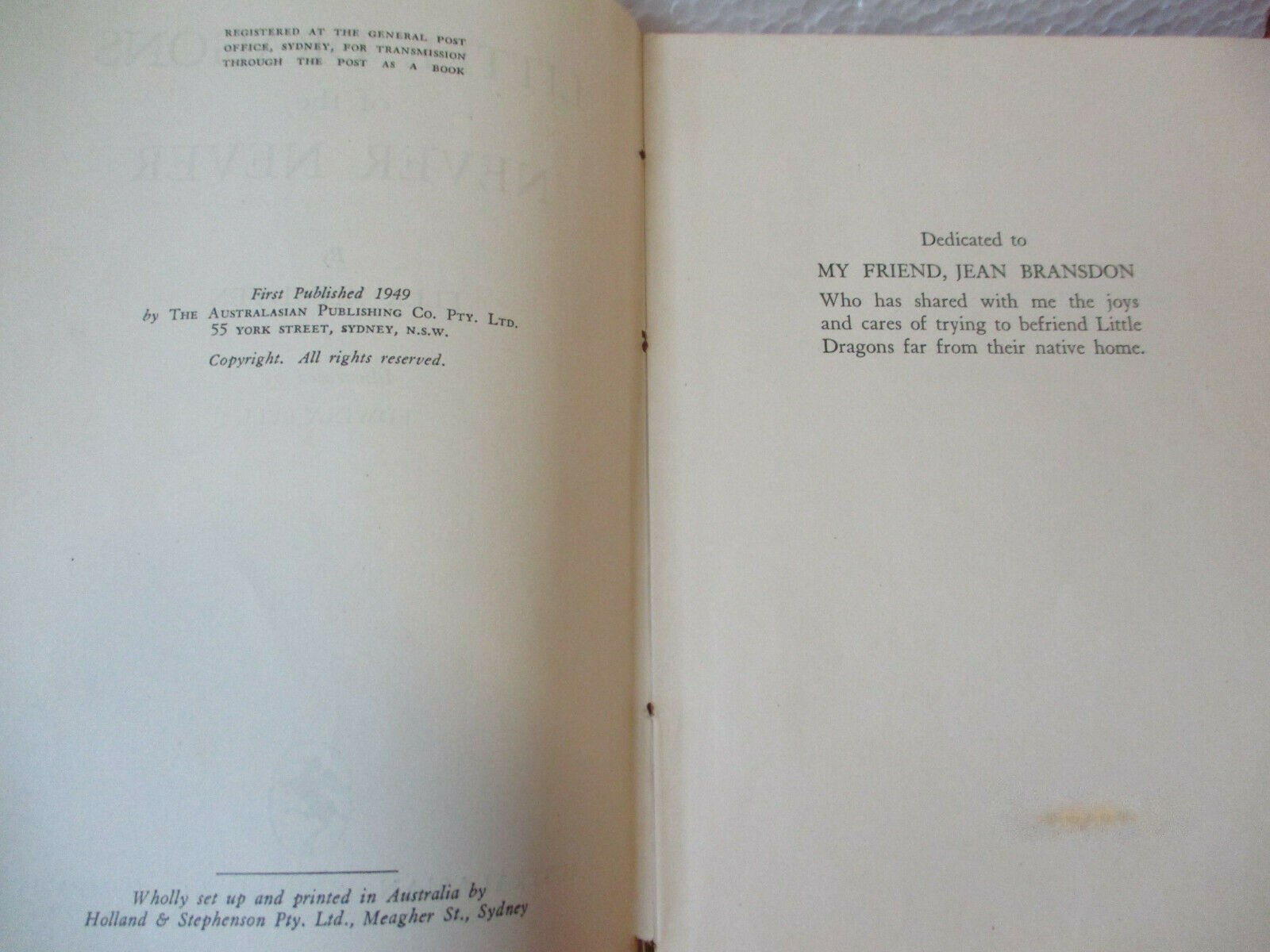

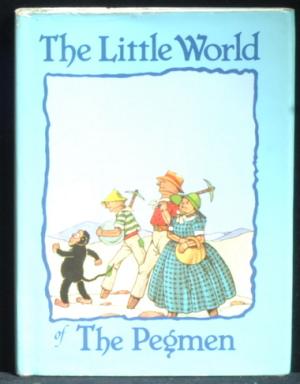
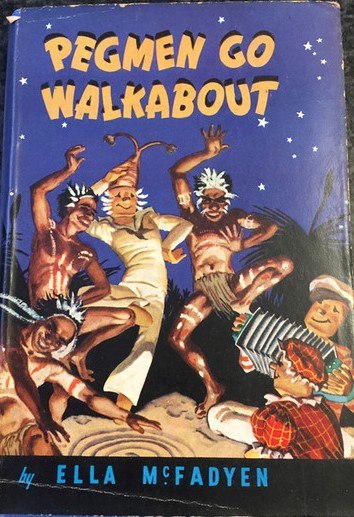
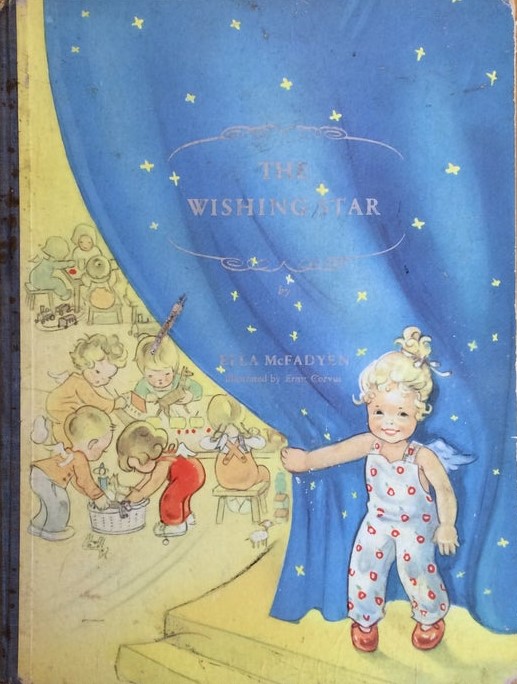
In the early 1920s she wrote the words for a series of part songs composed by Florence E. Axtens for use in schools. The songs she contributed to this series included "Till We Forget", "The Kangaroo", "Hush-a-Hush", "The Mosquito", "The Mountain Echo" and "Wattle Blossom".
Miss Florence E. Axten's Australian part-songs are rapidly becoming popular in the schools, and, woven around such themes as bellbirds, sheoaks, the kangaroo, and like favourites of the bush, they introduce a much-needed Australian colour into school music. Several of the lyrics for these simple little songs have been specially written by Miss Ella McFadyen ('Cinderella,' of the 'Sydney Mail') to subjects that, in some cases, were directly chosen by the children themselves. Miss Axtens is also the composer of 'Till We Forget,' successfully sung by Miss Rosa Alba on several occasions before her departure for Europe. Miss Alba has promised to introduce the song to audiences on 'the other side.' The melody and simplicity of the ballad have gained it appreciative notices, and several prominent musicians in Sydney predict for it a popular success. The words are by Miss McFadyen. Music & Drama (1922, March 22). Sydney Mail (NSW : 1912 - 1938), p. 13. Retrieved from http://nla.gov.au/nla.news-article169769989
" Till We Forget." Words by Ella M. McFadyen. Music by Florence E. Axtens. 10th April, 1922. 10227. Florence Ellen Axtens, 47 York-street, Sydney, N.S.W., and Ella May McFadyen, Lindfield, N.S.W. Children's part song: "Wattle Blossom." Words by "Cinderella" (Ella McFadyen). Music by Florence E. Axtens. 10th April, 1922. PROCEEDINGS UNDER THE COPYRIGHT ACT 1912. (1922, July 27). Commonwealth of Australia Gazette (National : 1901 - 1973), p. 1180. Retrieved from http://nla.gov.au/nla.news-article232526894
As the editor of the Australian Women’s Digest wrote in 1949, McFadyen was the “high priestess” of camping, “a veritable walking encyclopedia on insects, birds and animals, with a slight bias towards eels and lizards.”
McFadyen continued writing for children in her later years. She made regular contributions to the School Magazine, Junior Red Cross Record, nature magazines such as Wild Life and Walkabout, and the Fairfax press. She gave talks on radio, at schools and to the Zoological Society, and contributed play scripts to the ABC’s Youth Education Department. She wrote Kookaburra Comedies (1950) and The Wishing Star (1956). [2.]
Ella created characters that lived in distinctively Australian landscapes, under Australian trees, in Broken Bay and Pittwater caves, in the swamps of the Never Never. These tributes were a part of that growing rise of Australian stories for Australian people and children that underlined Ella's involvement in the literary community of her day and her lifelong passion for nature writing and bushcraft. Her body of work is so large, and she was so prolific, several volumes would need to be published to collate them all into one coalesced work.
After the position at Sydney Mail finished, and her work for the Sydney Morning Herald was scaled back, she was offered a position reviewing manuscripts for one of her favourite publishers, Angus and Robertson, work she did until three years prior to passing away - another dream job! The first manuscript she reviewed was Dorothy Walls 'Blinky Bill', for which she produced a condensed version. This book, first published in 1933, gives us a timeline for her work with Angus and Robertson - which, if records showing she went on with them until 1972, shows an almost 40 year career with them too.
a Gum Tree in Heaven



.jpg?timestamp=1580245774151)
.jpg?timestamp=1580261905908)
THE CONTRIBUTOR
THE TREES OF SYDNEY.
BY ELLA M'FADYEN.
McFadyen, Ella (1887–1976)by Leslie WalfordAs a child growing up on the outskirts of Sydney, Ella McFadyen wanted to read about Australia rather than children's stories with an English setting.So at the age of 15, she began writing her own — in nature pieces for weekly papers.Miss McFadyen wrote four children's books, including the classic Pegmen Tales and over 37 years was a regular contributor of poems and articles to The Sydney Morning Herald.Miss McFadyen's Big Book of Pegmen Tales was reprinted and published last year by Angus and Robertson, for whom she worked up till about four years ago as a manuscript reader.She died recently aged 88.The tales began originally as a daily serial for a Queensland newspaper and after running for three years were adapted for radio and then published into two books.The Pegmen were a family of pegs made by children (cousin of the McFadyens) on the Macquarie River and launched in a flood for a trip around the world.Miss McFadyen also wrote for a country newspaper, The Farmer and Settler. For 20 years she edited the children's or Cinderella page for the Sydney Mail. It was full of nature pieces, photographs and sketches of Australian animals and wildflowers. Stories from the United States (about "Disney types with black nobs on their noses," as Miss McFadyen called them) were firmly rejected.Associated with the page was a Boomerang Walking Club for which Miss McFadyen organised weekend adventure expeditions, teaching nature and bushcraft. Members had to show they could walk 20 miles a day before they could go on treks and like boomerangs, had to return home under their own power.Ella McFadyen developed her great love for the bush as a child.She is survived by two brothers, Lindsay in Queensland and Clifford in Lindfield.

References and Extras
- TROVE - National Library of Australia
- A slight bias towards eels and lizards by EMILY GALLAGHER, 8 March 2019, Inside Story, Retrieved from https://insidestory.org.au/a-slight-bias-towards-eels-and-lizards/
- Ella McFadyen interviewed by Hazel de Berg in the Hazel de Berg collection [sound recording available online]. Retrieved from: https://nla.gov.au/nla.obj-220870078/listen
- Series 04: Residences, homesteads, factories and farm buildings, mainly New South Wales, ca. 1879-1953 / collected by Ella McFadyen - State Library of NSW
- Series 09: Photographs of New Guinea, Fiji and Samoa, ca. 1927 / mostly photographed by Ella McFadyen - State Library of NSW
- ''MAITLAND" PARK.A New Proposal.(BY MARIE B. BYLES.)From the popular seaside resort of Palm Beach you look across the mouth of Broken Bay to a long line of coast-cliff and sandy beach interspersed by rocky headlands and crowned by virgin bush. Many people wonder what beauties lie hidden In these fascinating Tat-away beaches, and few realise that they are within easy reach of the launch which runs from Woy Woy to Empire Bay.It Is this last remaining strip of unalienated coastline reaching from Wagstaff Point to MacMaster's Beach that the Federation of Bush Walking Clubs Is seeking to have dedicated as a national park and preserved for posterity with all Its pristine beauties. For In a country renowned for its lovely beaches this stretch of land contains some of the loveliest. There Is Putty Beach, an ugly name for a magnificent reach of sand and surf. And then there Is the secluded "Little Beach," rock-encircled with golden starred meadows dropping down to its silver sands, and many another sandy cove tucked away between rocky headlands and sea-battered cliffs. Behind the shoreline are forests of macrozamia or kurrawong, that living fossil unique In the botanical world, while from the tops there aro wide views over ocean-bounded moors to the capes and inlets south of Barrenjoey.But the most beautiful beach of this coast-line is Maitland Bay, on whose northern head-land still Iies the remains of the wreck of the Maitland, which perished there in 1890, From the heights above Kilcare you drop down by a fern-green path, round some boulders and the exquisite half-moon curve. of Maitland Bay lies blue and gold below you, while away on Its further headland you can see the rusting boilers and tanks of that Ill-fated ship which have withstood the ceaseless beat of the ocean's surge for 30 years and more. And there they Iie to remind one, perhaps of the helplessness of many before the fury of nature, perhaps of the bravery of man when faced with danger, for the coolness and courage of the officers and captain of that ship make one proud to belong to the human race. As the blue sea breaks calmly at low water on the flat brown headland it Is hard to Imagine the Inky blackness and the howling of the tempest as they stood at their posts through a day and a night, but walkers who have camped on that beach with a fierce southerly blowing right up the bay know that those peaceful waves can often sweep up in tempestuous fury fatal to any ship too close to land.Sandy beaches, historic wreck, towering cliffs, and primaeval forest all lend their fascination to the proposed parkland which still Iies unspoiled as in the days when the "Hernia" reporter, sent out to gather news of the wreck, remarked ruefully-probably thinking of his torn trousers-that it was very rough country. It is the beauties of this primitive roughness that the Federation of Bush Walking Clubs is hoping to preserve for all time to meet the needs of the growing population of a large city whose park lands are all too few.[A photograph of Maitland Bay and Its fore-shores appears on the Illustrations page.] "MAITLAND" PARK. (1934, March 22). The Sydney Morning Herald (NSW : 1842 - 1954), p. 8. Retrieved from http://nla.gov.au/nla.news-article17067062
Fairy Stories and Fairy Poems galore - all of them related to Australian shores - and even at least one instance of getting her name wrong:
A PLOVER STORY.
Before Taking
After Taking
BY ELLEN M'FADYEN.
He was unattractive to look upon, a Spurwinged Plover somewhere about the prime of life, tall, spare, and erect, dull of plumage, long of neck, and, it would appear, weary of his existence. His long red legs, useful for wading purposes in his free days, were continually getting in his way, and making him ridiculous before the birds of the air. He himself was not of the air, but bound to the earth by the loss of a pinion, a fraction of bone and a handful of features, that made all the difference in the world.
Life, pleasant enough in reality, despite its restrictions, passed smoothly on the station. And there it seemed, by the banks of the Macquarie, life had every possibility of passing to its close. But he was by nature a pessimist, dark, thorough and complete, with but one reservation. The reservation himself took things in a manner that might be described as 'all serene.' He was a pert short-legged little chick, with a smooth black cap bordered with white, sleek bronze brown upper plumage, white beneath, and finished with neat grey stockings.
They styled him, locally, a Golden Plover. A captive since his earliest memory, he contented him-self with his lot, making frank return of the awkward yet benevolent affection that the Spurwing offered. But the routine of peaceful days came to an abrupt end in a barred and darkened box, into which the two captives were hurried away and entrained for Sydney. The lumbering of wheels, the clanging, the creaking, the continued rushing through darkness, interrupted only by equally terrifying periods of snorting and groaning, ended, however, in the bursting asunder of their prison house, and a welcome return to daylight. The two travellers found themselves comfortably installed in a latticed fernery with a sanded floor.
'Very useful !' said the Spurwing and he took a peck at the sand. Presently when their cramped limbs were stretched and their ruffled plumage preened, they looked about and took up the thread of life anew. During the day they had over an acre of garden and lawn and orchard to range, returning at dusk to be housed and fed. Their mistress bestowed upon the Spurwing the name of Sherlock, his tall angular form and long inquisitive beak suggesting a grotesque resemblance to the detective Holmes, as he appeared to the public in the illustrated magazines.
The Golden Plover was given the name of Otto, and in the roundness and completeness thereof was something suited to the plump, pert little birdie into which he afterwards grew. One day in the course of their hunting, they came to the drive gate standing open. Beyond stretched the grass-grown street of a scattered suburb, and just in sight lay an arm of Parramatta River. Darkness was falling, and a slight breeze brought the smell of mudbanks, mangrove-grown, and bared by the ebb tide.
Sherlock peered forth cautiously.
' Beyond,' said he, ' lies a land where we might hunt, free and fearless, to our heart's content. Come.' But Otto hung back.
' She would miss us,' he answered. ' Besides, there was bread and cheese for lunch ; there might be cake for supper.' Sherlock emitted a contemptuous s-c-r-r-ark.
'Cake!' he croaked. 'Cheese!'
Then, 'On the river we shall get fish.'
He ventured out, and Ottie pattered after. But the long red legs soon outpaced him, and the freedom of which he knew nothing offered but little attraction to his pampered senses. Sherlock popped his head right and left with a snake-like movement. Yes, he was pursued. He spread his clipped pinions, armed with the powerful spurs, and ran forward on tiptoe to gain impetus for the long, swooping flight peculiar to the wader. But the shortened wing crippled him, and he rose but a few inches. Otto meanwhile had submitted, and his fleeter companion was soon headed off and driven back to like captivity. There were fresh worms and salmon for supper that night, and the Golden Plover perked his little tail and emitted a satisfied tchuck.
But Sherlock sulked in a corner. Next day dawned heavy with fate. Their door was not opened after breakfast, but towards noon their mistress and other folk of the house came about and laid hands upon Otto. He shrieked despairingly as his little wing feathers fell from the scissors blade, and Sherlock charged gallantly to the rescue. In one brief moment an indulgent mistress had become a ruthless tyrant. For several days there had been unwonted bustle about the suburban home. Their mistress came in one night, and Otto was hastily aroused from slumber to find himself in prison. Sherlock's experience was somewhat similar. Hereafter was an anxious night, ending in a dawn that brought no light.
Another period of jolting, then sun-light, then their new home. There was earth beneath their feet, and through the netted roof of this new abode, wattles and a vision of tall trees standing out against the blue, blue tide of Brisbane Water.
'That girl,' said Otto, 'is still with us, so we shall be allright.' ' Let us be thankful that we meet again alive,' croaked Sherlock. Night came on, white and moonlit ; and all was silent. Presently, from far back where the bay terminated in a swampy creek, came a low, sad wail.
To Otto the sound was unfamiliar, but Sherlock started like an old veteran and s-c-r-r-arked feebly in return. The wail grew, shriek upon shriek, in a shrill, tumultuous crescendo, and dark forms, in pairs or straggling flights, passed over head. 'Curlews, all curlews, 'sighed Sher-lock, and then far and faint, sounded a cry that sent him beating widely against the wire, and screaming in a frenzy of delight. He had heard the voice of his brother. For two or three nights the birds, captive and free, but wild alike, called to each other thus, and then the stranger took courage and stole stealthily to the netted barrier. He was a very old bird, gaunt and unpreened, and he darted hungrily at the uninviting bread crumbs that had lain drying all day in the sun.
Somewhere in the marshy back waters of Narara Creek he had led a hunter's life, had won a bride and raised many generations of children, but his mate was dead and his prestige lowered. He was a straggler and an outcast, and he lifted a hoarse and feeble voice in lamentation when he found the wire impassable. Still he continued his visits ; he even grew reckless and haunted the rocky hill day and night. Broad day found him still beating about the walls. Sherlock croaked a startled warning at the sight of the son of the house, gun in hand, but the stranger turned and faced the foe, and the report was rattling in the hills before he took wing and disappeared among the brush and stones. And Sherlock mourned all that day in silence for the little tuft of white breast feathers lying in the grass. But next night the outcast kept tryst, though his while vest was stained with blood from a grazing shot wound.
Morning again found him searching up and down, but this time no gun shot startled the stillness, and off and on the tall bird carried on his quest till late afternoon. Then at last he found an open door. In he darted, up and down the sides, but no, it was empty. He scrambled under a hen roost and flapped against the closed-in roof. This was the wrong house after all, and he turned to find the door too late. A new actor had come upon the scene. The door was closed, and he was driven ignominiously into a corner. A cloth was dropped over him, rendering useless alike both beak and spurs, and he was lifted and borne he knew not where. Then, as swiftly, he fluttered free again, and stumbling upon his feet, darted forward to meet his brother. That night the stranger shared the banquet of fresh fish, and when the wailing of the curlews, flying out on their nightly mission, went by, the two Spurwings only drew closer together, and spoke in their own tongue of the dead days of their youth, and were content. A PLOVER STORY. (1906, December 12). The Sydney Mail and New South Wales Advertiser (NSW : 1871 - 1912), p. 1517. Retrieved from http://nla.gov.au/nla.news-article163684036
YOUNG FOLKS
WHERE THE STARS FALL.
BY ELLA M'FADYEN.
The paper lay spread under the Cootamundra wattle tree on the side lawn. A firmly-planted, holland-covered elbow held down either page, and served at the same time to support an obstinate little chin. The brown eyes above had not long learned the language of print, but they were proud of their accomplishment.
'If parents could only be convinced of the incalculable harm wrought upon a young and eager imagination by these idle and in credible fairy tales.' The active little brain behind the brown eyes could tip more understand the long words than the red, mischievous mouth could pronounce them, but the general drift was quite clear. Harry lifted his chin so that he might have one sunburnt fist free to. bring down upon the open page, Just as father used to do when denouncing some new move in politics.
'I don't believe It,' he cried, his voice trembling with indignation, his little frown meeting in a puckered line. Just at that moment he felt a hearty thump on his shoulder. 'Bravo, old man, that's the style.' Harry jumped up, he had believed the gar den to be empty. Nevertheless the voice went on, 'Did you ever see' a fairy?' Harry was a good deal startled, but he stuck to his guns.
'No,' he answered, stoutly, 'but I believe in them all the same/' It was rather uncanny, this conversation with an Invisible questioner.
'Why do you believe?' 'Because, oh, because I've just felt them.' Then he added, almost fiercely, 'You go down to the creek when it's all quiet and the shadows are long and sleepy, and you see if you don't feel the same. As if you could almost see them, just like on still nights you can almost hear the stars singing. Oh, I wish I could quite, instead of only 'almost,' ' he added wistfully.
'Softly, lad, do you really mean that? Very ?well, here I am.'
A little brown person, with a big head and mischievous eyes, stepped down on to the open paper, bowing low, cap in hand.
'By jove,' said Harry.
The visitor seated himself cross-legged, and laid down his cap. 'There are fairies,' he said, 'just as long as there are folks'who believe in them. Don't say again that you've never seen one.' Harry's first impulse was To put his hand over the little brown thing, as though it were a rare new beetle, but he conquered toe impulse.
'Why didn't I ever see you before?' he asked, under his breath.
'I've often been here in the wattle trees, one gets a pleasant sea breeze from the top, but I didn't quite know whether you were the right sort. I don't care to take my cap off till I'm pretty sure of the welcome I'll receive. See? It's a bit inconvenient to only be able to. appear to those who believe' in us, but It's a law that can't be altered. But now you have made me eternally your debtor.'
'What's that?' Harry asked.
'Oh, that if you want a good turn done at any time I'm your man. Anything I can do now?'
'I daresay there's really a lot of things if I could think of them, but what's your name, first?'
The brownie stuck a piece of grass in the corner of his mouth, and thought for a ?while. 'Name of Prickles,' he answered. 'At least it's this way. I'm fairly young for my family, Just about two or three hundred years. There was a big drought in full swing in the year that I was introduced to Australia; I've been thin and dry ever since — must have been impressionable. Well, my folk gave me a name I suppose, but a trifle like two or three hundred years even is a long while to re member a thing, so I forgot right out to »ave trouble.' 'But why Prickles?' Harry asked, staring hard at his guest. 'My friends call me that, 'cause I've got such a beast of a temper.' 'And those' who aren't your friends?' 'They leave me and my name alone, that's all.'
And the mannikin squared his elbows and doubled up his fists laughably. 'Then, if you please, Prickles, we'll be .very good friends.' i
'Just so, old chap; but you're an out size, you'll admit.'
He cocked his head on one side and considered. 'I might have you altered to fit,' he remarked thoughtfully. 'Here, catch hands, there, round about, and so. Feel a bit giddy, eh? Don't jump, that towering beetle Is only life-size after all.'
Harry laughed aloud. He was of a height with his little brown conductor as they waded knee-deep across the shaven lawn. Then he stopped with a sudden misgiving in his heart.
'I say,' he said, 'you're all right, aren't you? There are- brownies and brownies, you know, Prickles; and another migntn't like
'That's all right. I'm not one of your goblins or after-dark flitter-bats, you be wire.'
'Still, Prickles, you wouldn't mind me saying a bit of Latin, would you?' Harry pleaded.
'Fire away; mensa mensarum, eh?'
'Ah, Prickles, don't laugh. I mean church Latin, like there is at the top of the Psalms. 'Quare fremuerunt' and 'Laudamus, and— I can't think of any more; but that ought to be enough, and you aren't angry, are you?' 'Not a bit, old man, a very sensible precaution. Now, what will I show you?'
'I'd like to see the fairies dancing a magic ring if I might'
Prickles shook his head. 'There's no moon to-night,' he answered. 'Tell you what, though, would you like to see where the stars fall?'
'I thought,' Harry answered, 'that they fell into the silver wattles, and that's what makes the gum so bright and sparkling.
'Some of them do, but most that you see fall go Into the sea. They're white hot, too. and I've heard them hiss as they took the water, all still and black, and the bubbles boil up like silver globes as the star sank. You've seen phosphorus on the water at night?'
Harry nodded. 'I've seen It stick to the oars.'
'Well, that's just starshine. It's molten hot while the star keeps spinning, and when it falls the water is so much colder that the starshine gets pretty well solid; that's what you see shimmering at night. I shan't be able to take you down this evening, it wouldn't be etiquette; but if you hurry up I will find a guide for you. It's getting dark already, come along.'
They hurried across the lawn to the garden beds, and Prickles stopped and knocked at the entrance to a spider's hole.
'Saves a lot of time if you can take a short cut like this. Hullo, ma'am,' as two close-set, green eyes shone down the dark tunnel, 'I was beginning to think you were out.'
The spider beckoned with a yellow fang, and turning round revealed a succession of four pillars of emerald eyes. Harry and his friend followed down several dark turnings, and she bade them a civil good-bye at the entrance to a somewhat wider passage. Down this they ran hand in hand, brushing from time to time against scurrying bodies that gave them no heed.
'Don't mind 'em,' panted Prickles. 'Just brownies,. same as me. They don't mind us, anyway.'
At length they came out through a crevice in the rocks on to the sea beach. It was quite dark, and the still water below and the still sky above were lit with myriads of stars.
'Hold a minute,' cried Pickles. 'I must find the old man. Um-ah!' he rummaged among the seaweed till he found a little cave Just below spring tide line, 'Here we are. Winkles, I say, Winkles, look alive man I (Bother the old slow coach.) Here. I say!' hammering' all the time with his fists.
At last a little old man with a long white beard peeped out and asked mildly, 'Who's there, and what can I do for him? Ah, it's you, Corks, is it?'
'Yes, it is, I'm afraid— at least, it feels like me. (Calls me Corks, Hal, 'cause it Is so Jolly hard to keep me under.) Look here, Winkles, I want you to lend this youngster a suit of oils; the little green ones I had the other day will do. He's going down to night, and I'm afraid I can't take him. I'll meet you again here in an hour or two. Good-night.'
The little old man drew Harry into his cave, where the roof was hung with tiny nets all spun of moonshine and cobwebs. In a twinkling there was a little suit of green -shining stuff laid out ready, and Harry was into it in a minute. Then the old man brought him a draught of something in a deep sea shell, and they set out together and went down to a group of rocks, in one of the pools of which a couple of sea horses were tethered. , Away down through the dusky, cool, green water they flew on their spirited steeds, landing at last on a smooth sanded floor before a great wall of rock.
They dismounted, tethered their horses, and passed through a gateway to an inner wall, all draped in sweeping green weeds like thin silk. Here was a broad archway hung with a curtain of threaded pearls, and within all the floor was wonderful shining silver. But above them the light was soft and strained, making Harry think of some lines his mother had read him about 'The purple twilights under the sea.' Yes, that was it, 'purple twilights;!' but what was this wonderful pavement?'
The old man chuckled softly. 'Stars,' he whispered. 'That's what we do— pave the sea with 'em. Look!'
As he spoke some score of silver-scaled mermen came rollicking in, with a great netful of stars held between them, and after them a shoal of merry sea maids, who clasped their pretty hands at sight of Harry, and made much Of him, bearing him off to their coral caves and gardens of sea flowers, branching white coral stems and scarlet sea anemones, and peacock-hued, gossamer-tissued growths. And there were palaces where these merry people dwelt, wonderful palaces hung with precious store of sunken treasure and beautiful shells, and pearls, pearls everywhere, in this Inner kingdom of the sea. There were strange fruits to taste and sweet music blown on shells to listen to, and, ah, well! there are wonderful doings down there on the shining sea floor.
And, last of all, his kindly guide took Harry round to a quaint little cave with bars of rare black coral across the entrance. A stout porcupine-fish poked out his little pig like snout.
'Who's there now?' he grunted. 'You can't get in.'
'Why, you know me, Porfcie, dont you? This is a young gentleman a friend of mine asked me to show 'around. Got anyone interesting inside? This is the prison,' he explained to Harry.
The porcupine-fish puffed himself into a ball, erecting all his spines, then he blew off a few bubbles thoughtfully.
'No one to speak of. A few crabs, very uncivil fellows; a couple of boys, the sort that will fix corks on a fellow's spine, and half a dozen young barnacles who've run away from -home. Pretty slack time we're having. Good evening, sir.' Harry and the, little old man, having bid den good-bye all round, remounted their horses and returned to the beach. When he had got his suit ef oils off the young, adventurer found it very good to lie in the warm, dry sand and wait for Prickles.
And presently his companion offered to while away the time with a story of the first star that fell.
'It was before my time, you see, but the tale has been handed down, lad. If you look, it's easy to see where there ought to be another star in the Southern Cross. See it now? There's -a kind of blank in the centre. Well, that was the star, and brightest of all, it was, among the sky legions. But one night when the Cross hung low, our star looked down into what seemed another sky as full of stars as its own. But of all these one was brightest. Lad, the stars were young then, and how should they know ? The bright star was lonely because it was brighter than any other, saving only the twin star in the sea, so one night it slipped down— down— and left its brothers for a mirage, a ghost star that died even as they touched. But do you wonder at the sheen of the sea when you think of all the stars that have fallen?'
'Hello! Is the old sea-dog, spinning you yarns, eh?' shouted Prickles,' hurrying up. 'Come along, Hal. Sleepy? Yes, that's the sea-diving; it's time you were home. Goodnight, Winkles.'
Harry threaded the dark passages again with Prickles' hand in his, and Dame Spider let them out at her front door. When they stood again beneath the Cootamundra wattle the brownie reversed his spell and restored Harry to his proper size.
'Good-night, old man; they're calling you from the house. See you again soon, I hope, and by-the-bye, if you find anyone who believes — really believes, mind you — you may tell them this.'
And Harry told me.
YOUNG FOLKS (1907, August 14). The Sydney Mail and New South Wales Advertiser (NSW : 1871 - 1912), p. 434. Retrieved from http://nla.gov.au/nla.news-article163661544
A keen amateur photographer, the State Library of NSW holds a large cache of the images taken by Ella over the years that were donated by her younger brother after she passed away. The Sydney Mail was one of the first Australian periodicals to publish high quality photographs to illustrate its content, and one early one of Ella's, taken on the Central Coast (see above) appeared in the weekly. This one did not have those images incorporated but some of her 'road trips' and places seen along the way may be viewed online. Her prose, as exampled in this trip, underlines her love of the Australian environment and gives an insight into the places seen along the way, over 110 years ago:
THE SKETCHER
THE MOTORIST ON THE NORTH COAST.
BY ELLA M'FADYEN.
''Where the bee sucks, there lurkIn a cowslip's bell, I lie.'
.jpg?timestamp=1579131908933)

.jpg?timestamp=1579132372914)
.jpg?timestamp=1579132411753)

.jpg?timestamp=1579132460977)
